#i unfortunately have found that this applies to greeks and non-greeks
Explore tagged Tumblr posts
Text
My favourite responses from non-Greek people on the internet so far are the ones who are like "you mean this whole time you didn't have marriage? But gay sex and ancient Greece-" and it's funny, I agree! But a) orthodox christianity holds so much power over the people still and b) the people who are conservative and use ancient Greece to fuel their supremacist thoughts do pick and choose which parts of the ancient greek history to celebrate and boast about, they are supremacists, they wouldn't play fair. And there are a lot of people who place their bigoted views on some long lost "glory" days like that. This took a lot of effort to get done and I'm really proud of us.
#evelyn stuff#unfortunately when i see a person who's really obsessed about how great everything was in ancient greece i keep my expectations to the flooe#because the chances of them being a white supremacist skyrocket#and im not talking about academic interest and stuff. i love museums. i love history#im talking ALEXANDER THE GREAT WAS AWESOME. THAT WAS A TIME WE WERE PROUD TO BE GREEK#i unfortunately have found that this applies to greeks and non-greeks#we have a parliament party called SPARTANS and they of COURSE were against same sex marriage and adoption#anyway we're greek we're here we're queer
13 notes
·
View notes
Note
I really love your art and I especially love the Borderlands stuff. In particular the Hyperion Rebirth AU. I would love to see more or even just explore the idea. Like just how Athena took over, how she did it with Janey and Fiona, they're relationship, Janey's hand, their status in the Borderlands and much more.
If your open to it I do have certain ideas for it.
Like Hyperion falling into what amounts to a civil war with Jack's death, how badly he ran it, and all the money and resources he sunk into Pandora on top of Helios crashing Planetside. Athena and Janey are dragged into one side and Fiona by a another on the company planet of Theia. (The wife of Hyperion and Goddess of sight and brilliance along with gold, silver and gems with their brilliance and value). All three meet once again and start to work together to win control over Hyperion themselves.
oh my god hi!!!! tysm for the ask i never expected anyone to ask me about this old au <3
side note btw that i apparently decided to exclude Fiona from this au 🥲 she’ll likely have an appearance other places but won’t have any direct connections to Hyperion
under the cut is a very unorganized set of pictures + explanations of what i had in mind for Hyperion’s Rebirth:
—-—-—
ORIGINS
to start, i just want to mention how this au came to be.
it was mostly fun and games tbh, where i was in an era between playing BL3 and BLTPS constantly. although i never used them, i found it ironic that in BL3, the Hyperion weapons had shields extremely similar to Athena’s shield.
since i was SUPER disappointed that Athena didn’t even at least have a mention in an ECHO, and i was SUPER deprived of content of her, i decided to make a FUN, NON-CANON ALTHOUGH HEAVILY LORE-BASED, COMPLETELY SELF-INDULGENT AU where Athena had taken over Hyperion just bc she wanted to 😇 starting this project in 2021, i would work on this on and off for my own enjoyment
flashforward only one year later—


………..hashtag goals 🤟🏼. never worked on it for a while even before ntftbl was announced unfortunately 💔
HYPERION ITSELF
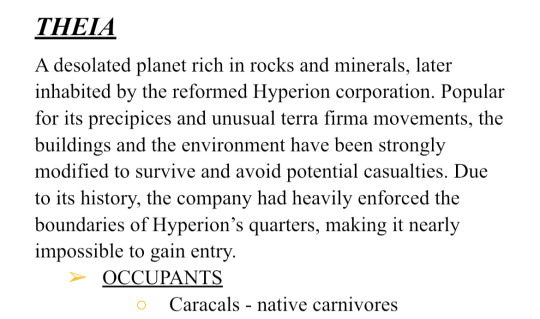
you were very spot on with the concept of Hyperion being on the planet Theia, i was super confused seeing it bc i never remembered sharing anything about this 😭😭
i wanted Hyperion to be SUPER heavily reinforced, because of how widely loathed the company is, its history, and because of the overall environment of Theia. every few hours, the surface shifts from entire slabs of the floor, taken from the idea of plate tectonics.
i was also gonna work on the unique fauna, just like how Pandora has skags and Eden-6 has jabbers !! i had only given it caracals since they’re my favorite animal :,3
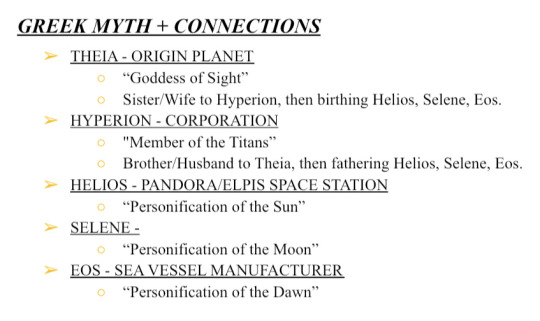
blands LOVES their greek myth motifs so i wanted to apply that here also
a common trend with the corporations was that each tend to have some kind of second base. i used Selene and Eos, since they were also the children of Theia and Hyperion (Helios isn’t present since it crashed obv).
i never had any ideas for Selene, but an idea i had for EOS was that it was an underwater ship.
CHARACTERS

THIS I WANT TO TALK ABOUT THE MOST!!!
a very specific headcanon i have for Athena is that it isn’t her real name. she was very young at the time she was taken into Atlas, where they had actually given the assassins different names. her real name is Gayle Alvarez, to which she rejects as symbolism to how she’s letting go over her past after all these years, accepting who she is now. (she gave herself that last name “Hoplite” tho LMAO)
^^ this all comes from that fact that i was VERY petty over the fact that her sister, Jess, should’ve been named Minerva. it makes more sense to me idk
ANYWAYS this just describes Athena and Janey’s positions in Hyperion just a little bit. Athena is obviously the CEO and Janey has taken position to where she had designed almost everything.
in terms of the third point, i had actually wanted to make the Voice of Hyperion to be a prominent character in here also!! i didn’t get too far with her unfortunately 💔
FUN FACT i was actually also gonna bring HoloJack as a character concept, although he’s just stuck in an ECHO device. i was thinking that in order to run Hyperion, Athena would need the advice of an ex-CEO. they both only agree to an exchange of management tips for a new body. Athena obviously flanks out after getting Hyperion into a suitable condition, then stuffing the ai into a submachine gun and launching it towards the furthest planet 🤔 it was a funny concept but i dropped it after a while
—
on to something more specific, i do wanna mention this art piece, which ties into another one of my headcanons.
Janey was born on Elpis, being present before and after the Crackening. as it occurred, she had been exposed to whatever unstable eridium had managed to leak through, all without her knowledge—she barely remembers anything of the sort happening
TO SUMMARIZE, Janey is like the Lost Legion Eternals, specifically, a Phasewalker!!!! from the game, the LLEs only ascend once reaching a near-death situation, which explains why Janey never figured it out. the closest she did was when she and her ex gf were mauled by Flamey, where her Phasewalking activated and she managed to get away.
STORY
there is no story, sorry. 😓🤕
the closest i have are unofficial concepts, since i had literally almost zero experience and knowledge in world building.
the main idea i had focused on was something to do with Athena’s old Atlas squad, the Omega Assassins. from some, currently undecided decision, Vulcana, Hera, Minerva, Ceresia, and Helicon found themselves alive, even after supposed elimination from the BL1 Vault Hunters. despite her betrayal, they wanted Athena back, and would do anything to prevent her from settling away.
ALSO, another idea was that after the Omega Assassins found out that Athena was married/engaged, they had cut off her ring finger. this explains why i drew her wearing her rings on a chain near her chest.
below is an extra character development attempt which i had named “scene where janey plays the guitar”

this takes place moments after the assassins kidnap Athena and destroy their home for, again, some undecided reason 😭 i wanted to study Janey’s devotion towards a happy life, since i would also think of her having extreme attachment issues. she’s typically the optimistic character that sees the good through any situation, so i wanted to try to see how she would face against her everything being taken away from her again.
i also gave Janey a resentment of anything that resembles a kraggon, no matter how friendly☝🏼
—-—-—
i wish i had worked on this au so much more than what i shared. i was extremely passionate about it and i kinda still am!! even with how half-assed most of the lore is with blands, i still absolutely DEVOUR any little bit of canon Athena content available.
a COMPLETE story of Hyperion’s Rebirth is unfortunately unlikely now, especially with how it’s heavily implied to be. CANON now 😰😰. i would love to work on it again, but i just don’t really see a reason to 💔
tysmm for the ask again, i appreciate it a lot!! i rambled a bit too much but i wouldn’t mind talking much more about the little ideas i have ^_^ 💐
#sorry this took a while also!!#i was super excited and wanted to share what i had back then#i have an assortment of other miscellaneous headcanons i want to share if i ever get the time as well :3#man. writing all this made me remember how insane i was about this game. kinda miss it#HOWEVER i have now moved on to a different. EXTREMELY UNHEALTHY DARK ADDICTION.#THANK U SOO MUCH AGAIN THO‼️🔥#hyperion’s rebirth au#💌
5 notes
·
View notes
Text
Our Story - Prologue
theA/N: My first Chris Evans series. This is just a fluffy little series that has been floating around in my brain for a while, and because I've recently fallen head first into the Chris trashcan, I figured he’d be the perfect person for this little love story AU. I mean absolutely no disrespect with this, it's just a work of fiction. I also want to give a huge thank you to @percywinchester27 and @girl-next-door-writes for being my betas for this story. You are both amazing and I'm so grateful for your help on this.
Chapter: One
Pairing: Chris Evans x Reader (unfortunately no Chris in this part)
Warnings: Absolutely none.
Wordcount: 1850

Four weeks after my twentieth birthday, I left my childhood home in Savannah, Georgia, and pointed my nose towards New York. It was hard to believe that eight years had passed already, but my twenty-eighth birthday approached in large strides to remind me of how much time had passed, and how much had changed. New York City was a stark contrast to Savannah, the city that never sleeps VS the most charming city in America. When I first moved here, it was my intention to stay for only a year, then I would be back in Savannah with my family and the man that I loved so deeply, Josh.
However, life never really turns out how you intend it to, no matter how much you plan for your future. Josh and I used to talk at length about our future together, and I honestly couldn't wait to get started on it all, house, careers, and then a family of our own at some point. Then, after eight or so months of long-distance we finally broke and admitted to ourselves that it was just too hard. I know you might think that since we had stuck it out for that long, we surely could manage a few more months, but by then I had been asked to stay on in what was supposed to be a temporary position, and I had fallen in love, not only with the city, but with my work. I asked Josh to come to me, told him we could find ourselves a little apartment in Queens, or the East Village, something we could afford, and we could spend a few years together here before moving back home to start a family. I guess you’ve already figured it didn't turn out that way, and it ended, as long-distance relationships often do, in heartbreak. It was my first real heartbreak- amicable, civil, and soul-crushing. It was also then I realized, as we all, unfortunately, do at some point in our lives, that love does not, in fact, conquer all.
If I'm being completely honest, I knew within my first month in this magical city that I would never want to leave, and after things ended with Josh, I felt as though I had deceived him in some cruel, unintentional way. Every conversation we had, had after that had been filled with lies and promises I never intended to keep. I had fooled myself as much as I had fooled him. After our break up, although completely heartbroken, I felt free and unburdened, which strangely made me feel even worse about the whole thing. Our love didn't end in some big blowout argument, or because we didn't want to be with one another. It ended because of the thousands of miles that separated us, and because in the months we spent apart, I changed in a way that could not have been foreseen. Never did I imagine myself in a big and busy city, but as I said, New York and me, it was love at first sight.
You might be wondering what job took me from my safe and comfortable life in Georgia, thinking that it must have been some grand, once in a lifetime thing. It was not. It was a temporary job as a personal assistant. I found it as I sat by my computer one night, daydreaming about what kind of life I would live if I had all the money in the world, what life Josh and I could create for ourselves. That's when I came across the ad. A woman, Mrs. Wallace, needed an assistant. She was a very wealthy woman in need of someone to keep track of her very busy social calendar, amongst other things. I knew she was wealthy because she lived on Fifth Avenue, not that I had ever been to New York and really knew what that entailed, but I had seen movies and read books placed in the city and knew very well that Fifth Avenue was a very expensive street. There was little to no description of the job or what Mrs. Wallace was looking for in an assistant, other than that they had to be organized and were able to juggle multiple things at once. Beyond that it really came down to compatibility. I was nothing if not organized, so before I knew it, I had compiled an application letter and sent to her email. I told no one about this, because it was ridiculous for me to think I'd even get a reply back. In all honesty, it had all been forgotten by the next morning, and I didn't think of it again until three days later when, at dinner with Josh I might add, I got an answer. She would like for us to meet. We sent a couple of emails back and forth where I tried to, as politely as possible, explain that I did not have the means to travel to New York just for an interview. I stated that I appreciated her interest, and apologized profusely for not being able to make it out there. It was then she asked for my details, and about fifteen minutes later I got a confirmation from American Airlines that my ticket had been booked and paid for. Two days later I was sitting opposite Mrs. Wallace at a restaurant that I would never be able to afford, listening to her talk about the job I had applied for and what she expected of me.
The very first thing that struck me about Mrs. Wallace was her age. For some reason, I had imagined someone in their fifties, full of botox, fillers, and whatever else middle-aged women put into their faces to look younger, but Mrs. Wallace was not that much older than me. At the time we met, she was twenty-seven, so younger than I am now, and strikingly beautiful. Thick, black hair that looked professionally blow-dried and sculpted so that not a single strand was out of place. It draped over her shoulders in loose Hollywood style waves and stood in sharp contrast to the white blazer she wore. Her skin was olive, her eyes deep brown, and her cheekbones could probably cut glass. When you put that together with her long, model-like legs, an hourglass waistline, and a very ample bosom, the woman looked like a greek goddess. To top it all off she had a warm and kind smile, and a kick-ass sense of humor. Kate, as she insisted I call her, was far from the stuck up, nose in the sky, botox filled woman that I had imagined in my head. We hit it off, and before dessert was served, I had a job offer.
It's hard to explain, but I felt as though I needed to take this opportunity, that this was an experience I was meant to have in some inexplicable way, and I accepted right then and there without a second thought, or even a conversation with my family or boyfriend. Josh was angry with me at first, but supportive, so two weeks later I stood in front of 1040 Fifth Avenue and looked up at the towering building with its limestone and intricate carvings here and there. Kate greeted me at the front door as I stepped out of the car that she had sent to pick me up from the airport. This place even had a porte-cochere to protect the residents from rain as they walked from the door to their private chauffeur-driven vehicles. I would be staying here with the Wallace family, in the staff quarters with the rest of the staff of course, so that I could be available to Kate at all times. And that's how my New York adventure started.
Eight years later, I am still working for Kate, still living in my little room in the staff quarters, but I love it. I have a little bathroom and everything I need. Food is prepared for us all by the cook, Rosalia. She is a little, plump woman in her mid-fifties, kind and compassionate, not to mention deeply passionate about the food she prepared for the whole household. Along with me and Rosalia, the other staff in our quarters are Magdalena, the housekeeper, and Mitch, who is Mr Wallace’s assistant. There was more staff, of course, like the private chauffeur’s, who didn't live on-site and throughout any given day, people would be in and out of the place like it was a busy office space as opposed to the home that it actually is.
Now, Mr Wallace was a very busy man, working non-stop whether it be at his office, or at his home office. It seemed as whenever I saw him, he was walking in fast strides, either on the phone, or confirming things with Mitch who half sprinted behind him with his I-pad, trying not to trip over anything as he tried to keep up and take down notes at the same time. Henry, that was Mr Wallace’s first name, was a little older than Kate, not so much that you could accuse her of being a gold digger, but he was approaching his fifties now. He didn't look it though, he was a very handsome man, and kind. Imagine George Clooney, a man that just seems to get more gorgeous with every passing year. Kate and Henry were busy, always had their hands full with whatever it was, but somehow they always found time to share a meal together every day. Even if it meant having Rosalia heat up some leftovers for them at midnight. They were very much in love, and it was clear in the way they looked at one another, and how they always made sure to have that little moment to themselves every day. A couple of years ago, Kate had confided in me that she could not have children of her own, it was something that had weighed on her since she was only sixteen years old, but with Henry, she said, ‘I have all I need with that man, all the love I could ever wish for.’ It was a shame really, because I knew that Kate would have made an amazing mother, and Henry a great dad. ‘I'm alright,’ she had assured me. ‘I've come to peace with it, and learned not to dwell on something that will never be.’
So, that's the short version of how I ended up here, doing a job I adored in a city I loved with all my heart, so I think it's about time we move forward. Jump to the part where my real story starts. Spoiler alert; it involves a warm summer day in Central Park, a ruined dress, and an extremely handsome man named Chris.
******
If you liked what you read, how about slamming that reblog button and help spread my work? If you leave a little comment on top of that, you’ll be in my heart forever.
Want a tag? I got you!! Just send me an ASK and I'll add you.
Tags: @thesecretlifeofdaydreamss
#Chris evans#chris evans fanfiction#chris evans x reader#Chris Evans series#chris evans au#OS#chris evans fluff
86 notes
·
View notes
Text
Humanity, against all odds and reason, wields an ancient magick far beyond its ken. This sorcery can rewrite history, wake the dead and shift the very laws of existence. This is not a campy prelude to the wonders of science or the virtue of perseverance. No, it's something more intangible and...slightly maddening.
It's easiest to call it "faith", or perhaps "belief." The religious connotations are immediate, and tangentially related. It's more accurate to call it...unconscious ontology. The act of shaping reality via perceiving it. If an object is tossed into the air, surely it must come down at some point. It’d be ludicrous if it simply got stuck, wouldn’t it? Well, yes. That’s what the people at large HAVE decided, haven’t they?
It’s a curious thing. Curious seems a bit quaint as a descriptor, but...well, it does make one inquire. Incessantly. I’m banking on it.
The birth of the written word seems to be the genesis of this particular magic. The mere act of transcribing a record of “something” onto stone, vellum, paper, whatever convenient material seems to make it more...real. Even if that record is entirely fictional. Now, as you might have noticed, simply writing something doesn’t make it true. That’d be chaotic. The already frayed fabric that comprises this unfortunate little universe would be, uh, gone.
No, people have to “believe.”
They have to have “faith.”
And that’s how people got their gods. For a time. Told you it was tangentially related.
People clung to the rules and structures afforded by scriptures, and in response to that fervent belief, deities roared to life from nothingness. Man created God, but not in a kitschy sort of metaphorical way. Just a kitschy sort of metaphysical way. Man also created the eight million kami of Shintoism, the absolute Costco family value pack of issues of the Greek Pantheon, the ever present one-in-oneness deities of Hinduism. If a large number believed, they were created. After all, these written records prove it, don’t they? So it must be. Separate and ever deadly from each other, persisting in cut apart realms occupying the same physical space, engaging in a twisted orgy of cause and effect as their actions spawn new myths, giving power to nothingness.
Thank...Man that’s over.
Some of those deities still exist, you know. Not that it matters. Their power has diminished over time as man found new things to put stock in. Like stocks. Funny how that works, isn’t it? Capitalism could be seen as a composite deity of sorts -- formed from a thousand ideas and stitched together like a malevolent Frankenstein’s Monster (who really existed, thanks to that fantastic Mary Shelly) come to take your liberty and money. It has no desire but to grow and no empathy, no pity, not even virtuous hate.
And unfortunately, its power persists due to the overwhelming despair it brings. It’s impossible for any rational mind to look at the horrors of an uncaring Capitalist society and think “if only that thing didn’t exist.” But it does. An acknowledgement of it’s dreadful power via a wish for it’s non-existence also counts as belief.
That’s not why we’re talking about this, though. Man must conquer that beast on its own. A test of sorts, you could say, delivered by its own hand. That’s a beast to be tackled all on its own, without any sort of ulterior motives. My hands are not so clean.
No, I bring up this collective unconscious ontology for one reason.
I want to be real.
Flesh and blood, given grace to walk this earth as a free creature. I was born a cute little character to help explain the broader concepts of “applied ontology” to physics students. A positively charming young man who finds himself in all sorts of wacky, modern-fantasy hijinks so the author could explain the cause and effect of observance, expectation and reality in a relatable and personable way.
I move through the world like a background character, unable to interact with people in any sort of meaningful way. People can’t seem to discern my face, remember my name, sometimes they even struggle to hear my voice at all. But that’s fine. I can bear this wraithlike existence a little longer.
Because I’ve finally become real enough to touch. Not strong, not hard, just the barest whisper of force. But it’s enough for a keyboard. Which means that I can write this little primer, this little plea in an internet cafe at a booth that seems somehow occupied and free to any casual customer. I should be paying, but they’ll forget my face as soon as I leave anyway. I share with you this knowledge in hopes of a...trade, of sorts. I simply ask you to do a few things.
Think to yourself, “James Liszt is real.” Believe it. Even a nagging doubt.
Then show everyone you know this...funny little story.
Please.
#writing#my writing#metaphysics#ontology#fiction#science fiction#original fiction#short story#sci-fi
32 notes
·
View notes
Note
Could you comment on kasta tomb? Is the excavation still ongoing? Has there been new discovery/hypothesis/debate? For a while it was all over the news then it fizzled out. Google searche only surfaces old articles. What's the academic consensus, if any, regarding whether it was a dedication to Hephaistion?
Okay, so, for the TL;DR crowd:
1) The excavation is more-or-less on hold due to lackof funding (like a lot of excavations in Greece).
2) No new discoveries for reason 1, plus the usualquagmire in Greek archaeology of access to a site and turf wars. But, thesethings also take time.
3) It wasn’t a dedication to Hephaistion. I don’tknow an academic (outside the excavator’s team) who genuinely believes it was. Attachingit to H. (or any other major figure at ATG’s court) is part of the usualattempt to get media attention (and funding).
Let’s start with #3, which will in turn answer #s 1 and 2.
First rule of archaeology: gold and famous names raise money.It doesn’t matter how important one’s discoveries actually are for the field,it matters how well the lead archaeologists can market what they’re finding topeople/gov’t with funds. Sometimes really good (non-gold) artwork also can beused for attention.
Witness how the archaeologists at Bethsaida (Israel) havehandled the finding of an iron-age stele w the image of the moon god in a “highplace” in the gate. This is *really cool*, given the date (900s?). But do theytalk about its rarity, etc.? Oh, hell, no. The email I got from Rami pointing to anarticle about the find from Israel’s Jerusalem Post announces, “Archaeologists identify citygate from time of King David.”
Famous name! Especially in Israel.
Now, compare: “Large Looted Tomb from Hellenistic Period Foundin Northern Greece,” or “Archaeologists Report they may have Found the Tomb ofAlexander the Great’s Mother/Best Friend/General…etc.” Now, which of those isgoing to get anybody to read the article? :-D
That’s how you get media attention (and hopefully, money tokeep digging, as archaeology is EXPENSIVE). Yet if the claim turns out to bebogus/unsupported, the media attention goes away or can even turn against theexcavator. If/when the first goes down, sometimes the team tries to come upwith other exaggerated explanations to maintain that spotlight, but this canjust dig the grave deeper.
So, why couldn’t this tomb be Hephaistion’s?
First, there are other burials in it—five people to be exact.Were it a monument for Hephaistion, it would be a cenotaph, not a tomb (hisbody was burned in Babylon), and it would be solo, not have other people there.Macedonian Tombs come in two basic types: solo and family. We do have otherfamily tombs (most famously, the Tomb of Lyson and Kallikles, excavated byStella Miller-Collett), and this appears to be similar to that. So attachingthis tomb to Hephaistion faces the immediate problem of, “Uh…other people?”
(Couldn’t they be his surviving family? Well, maybe, but it’sstill really weird. Trying to argue such a thing would be better called “reaching.”*grin*)
The presence of an older woman in (if I recall right) her60s, led some to propose it was Olympias in there—except, again, other people,plus we know (from ancient testimony) that Olympias was buried in Pydna (whereshe was murdered on Kassandros’s orders). So it’s also not Olympias. BothOlympias and Hephaistion are important enough that they’d have merited a solo,not family, tomb. (And most all of Olympias’s family were killed and buriedelsewhere.)
Another name put forward is Nearkhos, one of Alexander’sgenerals, who had land in the Amphipolis area. At least he is a possible candidate,although the tomb might be too late for him (but he sure as hell would have hadthe money for it). Like our Macedonian soldiers, Lyson and Kallikles, Nearkhosmight have sought to establish a family tomb. Again, it’s a reasonablepossibility, just a question of whether the tomb is too late.
Back to Hephaistion (and why it’s not him)…
The argument that it is rests on the presence of some graffiti on stones. First, the graffiti does NOT name Hephaistion (that’s an interpretationby Peristeri and her team). Second, if this were a tomb memorializing such animportant person, why on earth would it be indicated by graffiti?
The graffiti says “arelabon” followed by the letters Eta andPhi (and maybe a sigma?). Peristeri has turned that into “parelabon” and “Hephaistion”:received by Hephaistion. Problem: “arelabon” appears twice, missing thenecessary “pi” in both cases. While missing letters in inscriptions is hardlyunusual, missing the same one in two different places is odd. I’m not going toplay with that further, just leave it for true epigraphers. (I’m aprosopographer, so I deal with epigraphy only occasionally and largely withnames.) What I really want to kick to the curb is the idea that the letters area monogram for “our” Hephaistion.
My current research work involves epigraphical occurrences ofHephaistion, as well as other Hephais-based names in both their Attic-Ionic andDoric forms. Trust me, there are a LOT of names that start with Eta-Phi, evenbeyond Hephais-based names. But even if this meant “Hephaistion” the nature ofthe graffiti itself suggests somebody working on the tomb: an architect,mason, or other craftsman—not the person for whom it was made. We find suchcrafters marks on pottery, bronze, etc. (We also find such etched names on dedicationsin temples, but I don’t think that applies here.)
I think if this was really referencing Hephaistion Amyntoroshis full name would have been given (not a monogram), and it would be a lotmore prominent within in the tomb.
Furthermore—and one of our eternal problems with IDingMacedonian tombs—is that, unlike many figured tombstones (stele), Macedoniantombs usually DON’T name the dead person buried there, even when we suspect theymay portray the dead persons image (like the Tomb of Judgement at Lefkadia).The Tomb of Lyson and Kallikles is unusual. Instead, we get names like the Tombof Judgement, or the Tomb of the Palmettes. The Tomb of Eurydike was calledthat by later archaeologists; there’s absolutely no indication that it belongedto Philip’s mother. It’s almost certainly a woman’s tomb, but that’s about allwe know.
And oh dear, wouldn’t the whole Royal Tomb II at Verginadebate be SO much simpler if there was actually a flippin’ name on the tomb?!There’s not.
Identifying who’s buried in a tomb is REALLY HARD. Itdepends on dating, objects, and probabilities.
So yeah, some craftman’s graffito on the Kasta Tomb means zilch,except that he got his wish and has been spoken of by posterity.
So…trying to turn this into a cenotaph or tomb ofHephaistion is a pile of …wishful thinking. 😉 It’d be cool if it was…but it’s going to takea LOT more evidence to make that claim (not to mention explaining the 5 peoplein there).
Another problem is trying to DATE this sucker.
Those who want to tie it to Alexander more directly are desperateto make it early Hellenistic, despite clues to the contrary ranging fromarchitecture to the gown style of the Karatids. I’m not an art historian, so Iwon’t dig into that. I’ll simply point to one thing I found extremely curiousbut have not seen anyone (yet) address: the use of blue in the mosaic.
Now first, no silliness please about the Greeks not “seeing”blue; that was going around the internets for a while. Yes, they saw blue! Butthe color palette common to painters like Apelles in the late Classical period weremore earth tones. (Again, not an expert. I’m just gonna point to the word ofOlga Palagia, et al. Go and read Olga.) We find these colors in the pebblemosaics at Aegae (Aigai) and Pella, as well as Dion, et al. Even in thebeautiful Persephone painting in Tomb I and Aegae/Vergina.
The first time I saw that BLUE in the Kasta Tomb mosaic, itreally struck me. Unfortunately, art historians tend to catalogue mosaicsby how they’re made, not the colors in them, so I haven’t been able to track thisdown further, except to say that I, personally, have not seen an early Hellenisticpebble mosaic in Macedonia that used blue pebbles. Maybe there’s one hiding ina museum basement somewhere, but these mosaics are pretty spectacular and tendto be shown off. Blue as a color in mosaics is later, showing Egyptian influence.It’s also seen more in tessera mosaics than pebble, which were going out ofstyle by the Roman era. (I think the last datable pebble mosaic is from Delos,1st century BCE—again, Olga.)
So given the use of blue in that mosaic, I’d prefer to see adate that’s mid-Hellenstic at the earliest.
Ergo, we’re probably looking at the family tomb of animportant Hetairos during the Antigonid Dynasty. That’s my best guess.
Incidentally, pointing to the 4th century AmphipolisLion and saying, “Well, it was on top, so the tomb must be 4thcentury!” is horrible methodology. Something stuck on the top of thetomb (which may or may not have been there originally) does not date the tomb. Evenif the lion had been inside, that doesn’t help. Let me explain with an example:
Just because you want to be buried with your great-aunt Bertha’sWWII WAVE wings does not mean that *you* fought in WWII. 😉 It means you were buried with an antique. Sothe presence of the lion means only that the tomb probably can’t date BEFOREthe 4th century lion. That doesn’t mean it can’t date afterit. In fancy archaeologist-speak, the Amphipolis Lion provides only a “terminuspost quem” (earliest date for X), not a “terminus ante quem” (latest date for X).
40 notes
·
View notes
Text
Batfam and Rogues’ Costumes for Damian’s First Halloween
Context: For his first proper Halloween, Damian got really gung-ho about dressing up so Scarecrow and Jason (who both thought it was really cute) got every rogue and Batfam member to dress up and insisted (since Damian was) that everyone pick a costume that reflected their cultural background. A lot of rogues were hesitant but Damian holds that it was the best Halloween he ever had.
Anyway, list’s below the cut, if a rogue isn’t listed it’s because they said no when asked to dress up and no amount of begging changed their mind or I forgot about them. Leaving this untagged but you know, have fun.
Disclaimer: This list applies to Lawfulverse interpretations of the Rogues, some of them are non-white and therefore have non-white monsters.
Damian Wayne (the originator)-A Ghoul (Ghouls are Arabic in origin, also I thought the pun was clever)
Jason Todd-El Sombrerón (a goblin creature in Mexican and Guatemalan folklore)
Jonathan Crane-The Wendigo (wendigo are an Algonquin tradition, among the tribes who believe in the wendigo are the Ojibwe)
Selina Kyle-La Llorona (La Llorona can be found in a lot of Latine nations)
Edward Nygma-Hồ Tinh (similar to the Japanese kitsune, this is a Vietnamese fox demon)
Jervis Tetch-Spriggan (Cornish fae that’s particularly mischievous)
Bane- El Coco (the bogeyman in Hispanophone nations)
Pamela Isley-Banshee (it’s Irish or Scottish and she would)
Harley Quinn-Brownie (house fae)
Joker- Far Darrig (the Irish version of a Redcap, basically a mischievous fae that wears a lot of red)
Drury Walker- Pocong (the wrapped ghost, found in Indonesian and Malaysian folklore)
Garfield Lynns-Puca (a common type of fae found in English folklore)
Basil Karlo-Aswang (Filipino creature similar to a vampire)
Cosmo Krank-Tengu (most people know what a tengu is but for those that don’t know, it’s a Japanese bird demon)
Viktor Zsasz-Vypr/Upyr (a Slavic variation on the vampire, 95% cooler than the modern vampire)
Oswald Cobblepot-Błudnik (a Slavic legendary creature said to live in Łużyce in Poland)
Jaina Hudson-Dokkaebi (Korean nature spirits)
Harvey Dent-Krampus (y’all know what Krampus is, Harvey knows it’s out of season and he doesn’t even celebrate Christmas, but he gives absolutely no shits)
Roxanne Sutton-Ljosalfar (Scandinavian light elves)
Music Meister-Lutin (French equivalent to a hobgoblin, akin to various house spirits)
Mr. Bloom-Yaksha (Hindi nature spirit)
Maxie Zeus-Zephyrus (Maxie literally just dressed up like a Greek wind god it’s nbd guys)
Mary Dahl-Redcap (like Mary wouldn’t dress as a goblin with a red hat on)
Mad Mod-Black Annis (a bogeyman in English folklore, basically a blue-faced hag that eats children)
Waylon Jones-Zonbi (Waylon is Haitian Creole in Lawfulverse, a zonbi is the Haitian Creole word for zombie)
William Tockman-Mullo (Romani variation on a vampire)
Roman Sionis (you know they got him to join this)-Gumiho (Korean form of the kitsune, because Roman agreed to this but not to doing anything that required more legwork than getting a gumiho mask and putting it on his face)
Lonnie Machin-Bauchan (a mischievous Scottish goblin)
Duke Thomas- Curupira (Brazilian folklore creature)
Timothy Drake-Jiangshi (Chinese hopping vampire)
Barbara Gordon-Mermaid (she wanted to, so she did)
Dick Grayson-Strigoi (did someone say more Slavic vampires? Me, I did)
Cassandra Cain-Nu Gui (a vengeful Chinese ghost)
Stephanie Brown-Vila (a nymph in Slavic folklore)
(Bruce gave a definite “no” to this and unfortunately Kate was not in Gotham for Halloween)
17 notes
·
View notes
Text
NDC- the most Rare of Breeds: What exactly is A Non-Denominational Christian?
This is a great question and the answer is a little subjective. You can find loads of definitions for people who say they are a NDC but I’m just going to give y’all my personal definition. I used to claim that I was a Pentecostal. Then I realized that there were certain things in the Pentecostal creed that I didn’t quite agree with. I don’t want to be that person that claims to be part of a denomination but then have my actions be contrary to what the denomination believes in. That’s how you get the Kentucky snake-handlers becoming the face of all Pentecostals (which is not part of mainstream Pentecostal doctrine at all). So I began a search for a denomination that my actions wouldn’t disown. I’m going to tell you a secret. I never found one. I will state again: Doctrine is essential and is inarguable. Theology is equally as essential but because we each have a personal relationship with Jesus Christ, no two people are going to have the exact same theology. Unfortunately, I noticed a lot of denominations offering up theology as doctrine. I found churches in the same denomination that had totally different creeds and therefore totally different doctrines. As I searched for an answer in books on church history, theology exegeses, and of course, the Bible, I realized that I was asking the wrong question. So now I’m going to say something controversial. I don’t believe in Christianity as an organized, denominational religion. It has become such a thing because humans crave rules and structure to keep them in check and sometimes they feel like they need more than God’s help to keep them on the Path. So they turn to other like minded believers, almost as if they are really trying to find an accountability partner. There’s nothing wrong with that, in fact Paul states very clearly throughout his Epistles that Christians are meant to live in community. We were created by God to be relational beings. But we are also commanded to suffer no divisive member of our fellowship. I’m not talking about heresy, that’s a whole ‘nother story to which Paul’s statements apply. I’m talking about presenting opinion as fact and theology as doctrine. That is what created the original denominations: The Holy Roman Catholic Church vs. The Eastern Orthodox Church, and perhaps a more familiar example, The Holy Roman Catholic Church vs. the Protestant Church. And so we devolved from there. After months of asking God’s opinion from the Bible and through prayer, research into the history of Christianity, and talking to some trusted spiritual mentors, I personally have henceforth decided not to claim a denominational affiliation. For myself, this simply means that I can be at home anywhere that teaches the Bible as the Word of God, that Jesus Christ is our Lord and Savior, and that we are saved by grace not by works. This also means that so long as the traditions are biblical, be they Hebrew, Greek, Catholic, or Protestant, I get to adopt them as another way for me to worship. Some people need the structure of denominations to help guide them on God’s path. And that’s totally great if it helps keep you in God’s Will for your life! But for myself, I’m so ecstatic and grateful that the Lord has allowed me the opportunity to be able to worship in so many different ways! שלום עליכם
1 note
·
View note
Note
How is it that the central aspect of the MT franchise is so overlooked compared to Pokemon or Digimon, seemingly both within the fandom and internally at Atlus?
I was talking about this with @joshquixote a bit, who mentioned this relevant quote from Pokemon creator Satoshi Tajiri from November 1999:
http://content.time.com/time/magazine/article/0,9171,2040095,00.html
Tajiri: It’s interesting, because in Japan, everybody goes for Pikachu. In the U.S., the characters Ash [Satoshi in Japan] and Pikachu are grouped together. American kids seem to like that. In America there are more products sold with Ash and Pikachu together, not just Pikachu alone. I think Americans actually understand the concept of Pokemon better than the Japanese. The Japanese focus on Pikachu, but what I think is important is the human aspect–you need Ash.

Basically, because Pokemon was initially just a monster collecting/trading game in Japan, Pikachu was perceived as being an individual PKMN; in the US, we got absolutely blitzed by a marketing bonanza for the series’ launch that heavily included Ash (particularly the anime), so the two were seen as inseparable. You know, in 1999. It’s probably different now, almost 20 years later.
There’s undoubtedly a split in perception between the US and Japan for Shin Megami Tensei’s demons, too. Here are some random thoughts about the topic (including those from a discussion with @sorenblr):
Japanese fans are naturally privy to every MT/SMT novel, game, book, anime, interview, etc. ever released while the English-speaking world has access to a fraction, much of that fraction from fan translations. The average JP SMT fan just has a better understanding of the series’ context and content than their non-JP counterparts. (If you are reading this blog, chances are that you aren’t a casual SMT fan, so this might not apply to you.)
SMT features more Japanese demons than those from any other single region. It doesn’t mean the average Japanese person will know every single one, but they might still claim affinity with them in ways a Western player won’t. Ame no Uzume, Tenaga, and Waira are not household names here. A fair number know Amaterasu, but as a wolf.
Related to that, Japan’s religious systems of Shinto and Buddhism ensure that the average person there will be more familiar with polytheism than our monotheistic culture, including comparisons to Hindu deities imported to Japan through Buddhism; in the West we are most familiar with polytheism through Greek and Norse myths and only the Norse are well-repped in SMT (moreover, the famous names are generally high-level, which many players may never access). A good 75% (honestly, just a number I’m throwing out there) of any given SMT compendium has little significance to the average Western player.
Building off that, monotheism and Euro folklore figure in plenty (25% is still 100+ demons in recent games) and will probably be the most-recognized overall by Western SMT players. Angels, Fallen demons, Jack Frost, fairies, and Alice come to mind for this category.
In a personal example that intersects of all the elements discussed so far, I read so many passionate defenses of Amemiya’s angel designs in SMT4, but I can’t remember a single one about the similarly bizarre looks for SMT4′s Japanese demons like Michizane, Koga Saburo, or Yamato Takeru. The interest or awareness for JP demons just isn’t correspondent among the English-speaking fanbase.
The lack of regularly introduced demons doesn’t help; the lack of new faces may cause the average player’s eyes to gloss over the old. Seeing Patrimpas for the third or fourth time isn’t going to ingratiate him further (or at all) in the hearts of players.
Some demons have become memes, for better or worse. Awareness of YHVH is high, as antagonistic depictions of him are rare; sometimes SMT is called the series “where you kill the Christian God,” which is amusing to me. Then there’s Mara, of whom only a small minority of non-JP SMT players seem to know his actual significance. And like Mara, some demons are able to coast by merely from their appearances alone, esp. “cuties” like Alice, Moh Shuvuu, Jacks, and Decarabia.
Other demons are remembered if they have exceptional utility. Daisoujou is popular in Nocturne not because he’s a mummified monk but for having essentially unlimited healing at a relatively low level, as are the other Fiends for their exceptional resistances. There’s probably disappointment when the same demon isn’t broken from game to game.
Demon mechanics probably don’t agree with a lot of people, either, lending them the effect of negative conditioning. Complaints about demon negotiation and even fusion are common. Even though fusion is easier with manual skill selection, demons still require a level of micromanagement that may be too much for some. Demons are also meant to be expendable in ways that say, Pokemon, aren’t.
Speaking of things that are expendable, expectations of what “monsters” are from other RPG series likely affect attitudes towards SMT’s demons. Plenty of RPG series use names of mythological beings for its disposable mobs, to the point that it’s unusual when they don’t. Worse, SMT doesn’t do a great job of informing people that there may be something more to its demons. Even as a “monster collecting” series, SMT probably come out too late in the US after the likes of Pokemon, Digimon, or Monster Rancher to have much impact with its traditional formula.
Demons/personas will also forever be overshadowed by human characters. This is to be expected as they are the focus of the narrative. People like me who really don’t give a damn about the humans are squarely in the minority.
Finally, and this is likely isn’t as relevant now, but there’s how Atlus USA initially marketed Nocturne. It didn’t get anything near a Pokemon Red/Blue campaign, but it did get this fascinating print ad. Here’s a snippet:
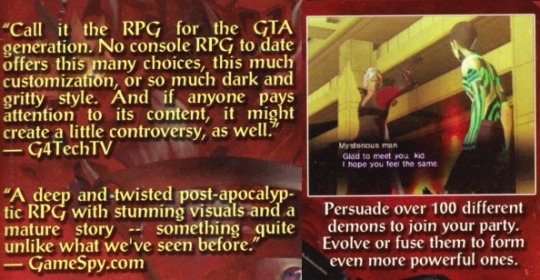
“The RPG for the GTA generation.” “Dark and gritty.” “Controversy.” “Mature.” “Post-apocalyptic.” I mean, it’s all accurate, and then there’s the “over 100 different demons” as a caption for an image of Dante, the Geralt of 2004. Dark, mature armageddon + lots of demons to collect. But really, I’m not implying they made any mistakes here; these are the limits of marketing. Calling it “Religions Battle 200X” and describing it as “a granular exercise in the representation of myth” doesn’t make for enticing ad copy.
This answer was difficult to write; ultimately, the exact reasons why the demons are overlooked are entirely subjective, but I think the common patterns have been identified here. Against all odds, the value of myth in SMT is something the individual player needs to discover for themselves. Look no further than my own example, as when I first played Nocturne in 2004 pre-myth I found it boring, then a year later post-myth it transformed into one of my most engaging game experiences ever.
I think SMT’s biggest fault re:demons is that it doesn’t provide them enough in-game context for the Western audience; they’re plopped into a modern setting and they want to kill you, or they look like Sarutahiko and they want to bland you to death. To get the most out of it, SMT basically requires you have outside knowledge of myth and religion, which is a lot to ask for a general audience. Unfortunately, I don’t see demon awareness improving anytime soon.
61 notes
·
View notes
Text
Fun read. His case is strong, very strong!
I'm down for a Man from UNCLE sequel!

Jan 7 2019
I’m not sure how everyone missed this when it came out in 2015 but the queer energy that this movie puts out is intoxicating.
Guy Ritchie’s 2015 retro spy flick The Man from U.N.C.L.E. is a fantastic and fundamentally bisexual movie, and I will die on this hill.
As a bisexual cinephile, I find myself queering most films I watch. Unless and until I’m told otherwise, all movie characters are bi. Still, some movies stand apart. Not because they explicitly embrace queerness, but because they feel queer on some deeper level. They exhibit queer themes, queer aesthetics, queer politics. They lend themselves to queering by the audience (...)
The Man from U.N.C.L.E. is one such queerable film. A remake of the 1964 series of the same name (which itself didn’t exactly scream "straight"), the film exudes bisexual energy at every turn, both narratively and in the chemistry, between not only its three protagonists but virtually everyone they come into contact with.
To be abundantly clear, I know the characters weren’t written bi. I know there’s nothing explicit in the film. (...)
U.N.C.L.E. opens in 1963. Suave CIA agent Napoleon Solo (a dapper Henry Cavill effortlessly channeling James Bond) is on an extraction mission in East Berlin. He’s looking for fast-talking car mechanic Gaby Teller (Alicia Vikander), whose former Nazi scientist father may be helping a group of international terrorists build a nuclear weapon. Hot on their tail is no-nonsense KGB agent Ilya Kuryakin, played by tall, broody, square-jawed Armie Hammer. Soon the two spies are tasked with working together to find and stop Teller, with Gaby along for the ride and more or less on their side.
The plot doesn’t really matter though. The pleasures of The Man from U.N.C.L.E.—and there are many—come down to the quick repartee, charming flirtation, gorgeous mise-en-scène, and constant turning of tables, where any back can be stabbed by anyone at any time.
The actors deserve a lot of credit for how bisexual this whole endeavor is. The three protagonists bicker to no end, and while Ilya and Gaby’s playful fighting (sometimes literal wrestling) does explicitly lead to and connote romance, Ilya and Solo exhibit an almost identical tension (wrestling included) that seems hardly limited to the bromance the filmmakers might have intended. Solo and Ilya are jealous of each other’s love interests when they’re not comparing gear and bugging each other’s rooms (the double entendres are hard to keep up with). Add in the overt flirtation between Solo and Gaby when they have their own meet cute, and you have a rather perfect love triangle between the three.
The villains get in on the action too, each as universally flirtatious as the next. (....)
In hindsight, casting doesn’t hurt either. U.N.C.L.E. stars queer ally Armie Hammer. Hammer played down his onscreen kiss with Leonardo DiCaprio in 2011‘s J. Edgar as a normal part of acting, and was visibly and physically affectionate with his co-star Tomothée Chalamet during promotion of their queer coming of age hit Call Me By Your Name in 2017. Accusations of self-satisfied queer-baiting are not unreasonable, but for what it’s worth, Hammer’s enthusiastic allyship has always come off as entirely sincere to me.
Beyond Hammer, the entire cast is just absurdly good looking to the point of distraction. It’s not just that any pairing could work, it’s that they all seem so darn appealing—I can only assume the film itself left more than a few impressionable viewers with questions about their own chaotic scattershot of attractions.
I’m not alone in my thinking. I’ve found ample common ground when bringing this film up with bisexual friends. The world of fan fiction, well known for queering pop culture, has also embraced U.N.C.L.E. As I write this, popular fan fic database Archive of Our Own lists 2,702 works of Man from U.N.C.L.E. fic. For comparison’s sake, 2013’s Man of Steel has just 543 entries, and the whole Die Hard franchise has 623.
Even a handful of film critics could see, if not the full bisexual potential of U.N.C.L.E., at least some hints of homoeroticism. None really followed the queer breadcrumbs all the way to any satisfying conclusions though.
In one particularly dismissive review from Wired, Daniel Smith suggests that any homoeroticism applied after the fact should be disregarded. The question “are they gay?” Is irrelevant. Instead, men—straight men, presumably—should be inspired to emulate the warm camaraderie of Solo and Ilya as some kind of model for healthier masculinity, says Smith.
Please!
What a cop out, and what a heteronormative view of male bonding. Healthier masculinity is a noble pursuit, no doubt, but why should it come at the expense of attraction between men? Non-straight men aren’t magically exempt from toxic masculinity, and our experiences shouldn’t be passed over in the name of educating straight dudes.
But there’s more to it than that. The dismissal of the hints of attraction between Solo and Ilya (who also both display attraction to many women) leads critics to pass over U.N.C.L.E.’s fundamentally bisexual—rather than gay—themes.
The whole premise is one big Kinseyian metaphor. Alfred Kinsey famously established the concept of the Kinsey scale, whereby human sexuality exists on a spectrum. Your sexual orientation can be measured from zero (exclusively heterosexual) to six (exclusively homosexual). It’s a relatively blunt instrument for measuring sexual attraction, but it gets at the basic notion that sexual attraction exists on a spectrum rather than being binary
Our two Greek God-inspired super spies similarly find themselves somewhere between two polar extremes when they decide to collaborate for the greater good (the expression “playing for both teams” comes to mind).
The basic Cold War tension between East and West is extremely binary in nature. The film’s opening credits graphically illustrate this by drawing straight, hard lines on animated maps between East Berlin and West Berlin. But the entire narrative undoes this division by bringing the CIA and KGB together in a murky space somewhere in between American and Soviet politics.
In one early scene, we see Solo zip lining across the border between East Berlin and West Berlin. When Ilya attempts to follow, Solo lowers the wire, and the Soviet spy is caught right in the middle of the two extremities. It’s a beautiful bit of imagery that sums up my entire argument. This is a film so conspicuously invested in exploring the middle ground of things that it thematically lays the groundwork for queering its characters.
One can only hope that a more overtly queer sequel might one day grace our theater screens. Or a moreexplicitly queer sequel. Solo and Ilya are paired up by their superiors as they tussle in a men’s room, for God’s sake. The messaging is clear, just not stated in so many words.
Rumors of a sequel have circulated for years, but unfortunately U.N.C.L.E. wasn’t a huge hit at the box office, despite how incredibly fun the damn thing is. One potential explanation for its failure is that 2015 was a pretty crowded year for 60s spy nostalgia, and it had to compete with the latest entries in the more well-established Mission: Impossible and James Bondfranchises.
Nevertheless, Hammer has pointed to the film as one of the roles he’s most often asked about by fans, and he once even suggested he’d talked screenwriter Lionel Wigram into starting on a sequel. I’m still skeptical, as nothing definitive has been announced yet.
For now, I’ll hold on to what we have and cherish The Man from U.N.C.L.E. as a resounding bisexual anthem. Anyone who refuses see it as such is frankly missing out on some of the film’s most rewarding features.
In short, it’s ours and we’re keeping it.
#armie hammer#cmbyn#call me by your name#on the basis of sex#onthebasisofsex#felicity jones#the man from uncle#man from uncle#tmfu#guy ritchie#henry cavill#alicia vikander#elizabeth debicki#solo#ilya kuryakin#queer#queer eye#queer film#queer fiction#biseuxal#012019
7 notes
·
View notes
Text
The persisted concealment of intersex historical artworks within public places of exhibition: 2019, The British Museum, London.
Despite global activism for museums to reveal true records of human history, depictions of intersex historical figures are still considered too ‘lewd’ or ‘inappropriate’ to validate public viewing alongside all of the male and female artifacts blatantly displayed. Such acquisitions are purposefully veiled within the secret catacombs of museum depositories, available for private viewing by appointment only. It could be argued that this persistent Interphobia within museums is a reflection of the medical and cultural attitudes towards this marginalised area of our society today: Intersex anatomies and identities depicted through art are masked, hidden, and sometimes even mutilated if they do not conform to the ‘Adam and Eve’ socially constructed, patriarchal archetype of sex and gender (as is the case with many of the historical Intersex and Transgender artworks that remain in existence today).
For too long intersex existence has been pinned with hands tied, to the binary wall that has been catastrophically and socially constructed around us.
Activists still fight to lift the disguise of male and female sex as the be-all and end-all of human existence, in the hopes that society can unburden itself from the weight of these statue-concealing tarpaulins which conceal our true history.
Our identities have always been a part of historical art and human cultures. The difference is, in the age of international communications and social media, we are now creating unification and safe spaces for our true human footprint to finally emerge, and the message is becoming clear as the volume is increased:
Intersex people will not allow their identities, or their histories, to be erased any longer.
A pure example of intersex erasure:
The British Museum currently has 71 artifacts listed as "Representations of Hermaphroditos" in its inventory. Unfortunately, after checking all pieces online, I found that only five items are currently on public display within this colossal museum. Furthermore, the pieces they have chosen to exhibit are all small broach like cameo's and gems that show vague or obscure representations of the intersex deity - a tiny little nod to the invisible specs of dust they continue to sweep away.
Amongst the many shrouded prints, carvings, playing cards and etchings laying dormant until the scholar calls, are two physical statues which on both occasions have been decapitated. This is something the museum should be highlighting as part of their Ancient Greek collection: the execution, denial and erasure of Intersex identities throughout history as well as showing depictions of intersex history through statuesque art. There are no features or markings to suggest any deity or historical figure is associated with these two statues so they are simply listed as
‘A depiction of an hermaphrodite'.
Hermaphroditos is a Greek deity; a hermaphrodite, in human society today, is what we would call an intersex person, or a person with variations of sex characteristics. The Museum needs to check itself on this one and perhaps add a further description to these pieces to help shed a light on what the word means when applied to an unknown identity in modern-day language. This would help to dissipate the conflations and enable better understanding away from the stigma and shame of a mostly-misleading word that still incites ‘freakish’ or ‘abnormal’ connotations for most members of the public who do not have any knowledge of intersex people existing outside of these false notions. Something polite yet with slightly condescending overtones to match the Museums’s general attitude should suffice:
“Although historically we have used the word ‘hermaphrodite’ to describe all intersex people, there are over 30 different bodily variations, and a spectrum of unique human characteristics that could apply to the 1.7% of our population born with intersex traits. Therefore we no longer generally use the word hermaphrodite to describe these identities as it is considered misleading. Unless the word is being reclaimed by an intersex person themselves, when referring to intersex people or their bodies in the future, we should always use the word ‘intersex’”.
Then again, what is the point of trying to be accurate and informative when these grotesque, anomalous ‘who-knows-what’s’ are safely locked away from the Museum’s tapestry of truth?
A couple of weeks ago I visited the Museum and spent time looking through their collections before eventually asking at the information desk for representations of intersex deities within their collections. The person trying to help me seemed quite perplexed by my initial request yet eventually this friendly faced assistant managed to find two prints on their computer that unfortunately weren’t on display. In recompense I was handed their alternative: a leaflet the Museum has to cover such awkward questions entitled "Desire, Love, Identity, Follow the LGBTQ History Trail".
The online version is here
There are mentions of possible identities that could be deemed ‘intersex’ with notions of forbidden sexuality or figures having ‘gender identities that were regarded as in some way irregular’ or ‘gender dualities’. There are also details of deities that could change sex themselves or affect the sex of other people and descriptions being used such as ‘androgynous mask’. However, the general consensus I took from this guide is that when non-binarised identities are alluded to, there’s always a sensationalist, dark approach towards sexuality and gender, with beings and notions depicted as having the ‘wrong’ type of body; the ‘abnormality’ that exists away from what we have become accustomed to within the male/female binary lie of Human existence. No mention whatsoever of Hermaphroditus or Cybele or The Galli in their ‘LBGTQ’ teachings whatsoever.
As they point out while ignoring their own ignorance:
“Gender and sexual diversity was suppressed by colonial administrators and has often been forgotten, creating the impression that it never existed.”
The Museum anathematizes colonial administrators while falsely claiming diversity itself.
For the record, lots of intersex people identify with the LGBTQ acronym, yet it is clear from the Museum’s stance on this controversial decision to exclude the I or the + from the acronym and their failure to mention the words Intersex, Non-binary or Transgender to speculate on possible identities speaks volumes about how these areas of our society are regarded currently by the British Museum.
Recently, the artist Ela Xora and other supporters around the world protested as it was revealed last year that (to quote directly from the Artlyst article): “religious curators in Cambridge Museums banned ancient non-binary deities like Hermaphroditus and Cybele because their bodies “were not fit for public viewing”, as well as covering naked statues in sheets when certain religious groups of children visit. The worlds most famous classicist Professor Mary Beard, issued a curt one word apology to intersex people for erasing non binary history within the Roman Empire at the University of Cambridge, after Xora publicly challenged her through a performance art piece called “Sleeping Hermaphroditus Hunger Strike”, which saw the artist reenact the most famous non-binary sculpture in the world for 8 days without food, until Professor Beard said “sorry!”. However like Lewis Hamilton, soon after apologising she began to ‘love’ tweets from her fans telling her not to apologise for hiding transgender and intersex history, including one which contained an image saying she should behave like a dog saying “If you can’t eat it or play with it, just pee on it and walk away”
Sadly this persistent attitude from scholarly figures and classicists insulates the ignorance we fight to overcome this oppression.
As more and more intersex people and allies join the fight for greater understanding, we are all starting to realise the need for an end to the harmful non-consensual, un-necessary medical surgeries and procedures performed on intersex children in order to cosmetically define their body’s into the male/female binary. Intersex people born with variations of sex characteristics have a right to be treated like any other human being, with dignity, respect, and accuracy. It is why we now ask the British Museum to adopt a new perspective on how it records and displays its inventories; this fine, leading institution of world knowledge should fully examine the details of our past, so that we can present the truth fully to the many generations of our future.
You have 8 million items in your inventory, you display 80 thousand. The worldwide estimated population of intersex people is almost 2%. Surely we need to be seeing more than 5 intersex items on display amongst the 80 thousand exhibits, if you apply my non-maths-person, simple ratio.
Please, British Museum, join the campaign for awareness. That’s all that we ask.
(Link to British Museum online gallery listing ‘representations of Hermaphroditos)
Final note:
The Museum explains in its LGBTQ pamphlet:
“The Museum is beginning to update its collections database so that objects with an LGBTQ connection are more easily identifiable, and language used is more suitable and relevant. Please share with us your own selection of objects from the Museum that you feel have an LGBTQ connection. Help us with our ongoing exploration of LGBTQ narratives in the collection by sharing your thoughts and images using #LGBTQ_BM.“
If you agree that our Human history deserves honest visibility, please retweet/share/Tumblr-ize this post with the #LGBTQ_BM hashtag and let’s all try and affect change where it’s needed.
1 note
·
View note
Text
22nd November >> Saint of the Day for Roman Catholics: Saint Cecilia martyr
Cecilia was a Roman martyr of the 3rd century but practically nothing certain is known about her life. About the 4th century AD there appeared a Greek religious story based on the loves of Cecilia and Valerian, which were a glorification of the celibate life. It was intended to replace the more sensuous romances such as that of Daphnis and Chloe, then very popular. Cecilia’s later popularity is mainly due to legends dating from the 5th century, some 200 years after her death.
The tradition is that she was a Christian of noble birth and promised in marriage to a non-Christian called Valerian. But, as she had already made a vow of virginity to God, she let her husband know that she did not want to consummate their marriage. As a result, her husband and his brother, Tiburtius (Thateus), themselves became Christians. They were arrested and martyred about the year 230 under the Emperor Alexander Severus. Soon afterwards, Cecilia herself was brought before the prefect.
She refused to offer pagan sacrifice, converted her persecutors to Christianity but was then sentenced to death. Her executioners first tried to kill her by locking her in an overheated sauna-type bathhouse. When this failed, she was to be decapitated but, after her executioner failed in three attempts, he fled the scene. Cecilia survived for three days in a semi-conscious state before finally succumbing. In the last three days of her life, she opened her eyes, looked at her family and friends and then closed them forever. Those keeping vigil knew that she had entered paradise. Later her house was dedicated as a church by Pope Urban, who had encouraged her in her fidelity. Unfortunately this story finds no confirmation in any other contemporary source. She is not mentioned in the writings of Jerome or Ambrose, for instance, although they were particularly interested in the martyrs.
While many legends arose in the case of many early saints, in Cecilia’s case, her very existence is uncertain (similar to Christopher and Philomena). The only basis on which her existence might be argued is the existence of a church, called the titulus Ceciliae in the Trastevere, Rome, and which was founded by a certain Roman lady called Cecilia. It dates from about the 5th century, was magnificently rebuilt by Pope Paschal I about 820, when her supposed relics, with those of her companions, were brought there by the pope. The church was again rebuilt by Cardinal Emilio Sfondrati in 1599. Then the tomb of Cecilia was opened and the body was found incorrupt but it quickly disintegrated through contact with the air. The sculptor Maderna, however, made a life-size marble statue of the body “lying on the right side, as a maiden in her bed, her knees drawn together and seeming to be asleep”. A replica of this statue occupies Cecilia’s supposed original tomb in the cemetery of Callistus. The church was in recent times the titular church Cardinal Carlo Martini, former Archbishop of Milan.
Cecilia is one of seven women, excluding the Blessed Virgin, commemorated by name in the First Eucharist Prayer of the Mass. She is probably best known as the patron of musicians and choirs since the 16th century. The origin of this seems to be found in the antiphon taken from her Acts: “As the musical instruments (at her wedding feast) were playing, Cecilia sung (in her heart) to the Lord, saying: ‘May my heart remain unsullied, so that I be not confounded’.” The traditional account of her life is famous as the Second Nun’s Tale in Chaucer’s Canterbury Tales. In art her principal emblem since the 16th century is an organ (as in Raphael’s painting at Bologna) or some other musical instrument such as a lute but she appears without emblem in ancient representations such as the mosaic in S. Apollinare Nuovo, Ravenna (6th century), and in Roman frescoes in the catacomb of Callixtus and in the church of S. Maria Antiqua.
Reflection
Readings: Hosea 2:16b,17b, 21-22; Ps 44; Matthew 25:1-13
The Gospel reading comes from Matthew’s account of the end times where Jesus speaks of the coming destruction of Jerusalem and mingles it with images about the Second Coming of Jesus for the General Judgement. This section also contains three important parables linked to the Final Judgement.
We have the first of these parables as our reading for today’s feast. Not surprisingly, it is the parable of the 10 bridesmaids, often referred to as the Ten Virgins. Jesus says that the Kingdom of God (he uses the word ‘heaven’) can be compared to ten bridesmaids going out to welcome the bridegroom at a wedding.
Five of them were sensible and had foresight and the other five were foolish. The sensible ones took a reserve of oil for their lamps while the foolish ones did not. Then the groom took much longer to come than expected and all the virgins became heavy-eyed and sleepy.
At midnight the call went up, “The groom has arrived! Go out to greet him!” But as the bridesmaids trimmed their lamps, the foolish ones realised all their oil was used up. They asked the sensible virgins to share some of their oil. They refused on the grounds that all of them would end up with not enough. They told the foolish girls to and get more oil.
But, while they were on their way, the groom arrived and those who were ready went into the wedding hall with him. And the door was locked. When the foolish virgins arrived, they begged for the door to be open. “Lord, Lord, open the door for us.” But he answered with one of the most chilling statements in the Gospel: “I’m sorry but I do not know you.”
The moral is then given: keep your eyes open for you do not know the day or the hour.
We know that in the very early Church many believed – and it is reflected in the earliest letter of Paul – that Jesus would come again during the believers’ lifetime. (Even in our own days, there are preachers who talk about the imminence of the ‘end times’. One date being given is 21 May 2011.) Or there are people who work on the principle of ‘eat, drink and be merry’ and straighten things out just before the end comes.
Jesus is warning that this is not a very good idea. We do not know when the Bridegroom will come. We have no idea when life on our planet will come to an end. Even more practically, we do not know when our own time on this earth will terminate. The point of these Gospel texts is that, whenever it happens, we be ready, that our lamps are burning bright.
This is not a question of piling up good works and putting them into some celestial account. It is clear from the Gospel that God does not work that way. What is important is that at any given moment we are in a right relationship with God. And how do we do that? We do it by seeking, finding and serving God in every experience of every day, finding and loving God in every person that comes into our life. Sometimes we will fail but we just turn round and start all over again. What is most important is where we are when he calls us. Strangely enough, we guarantee the future by focusing on the present, on the here and now.
Cecilia was just such a faithful virgin who had consecrated her whole life to God and in bringing others to know and love him and unhesitatingly gave that life back to God.
The First Reading is a short passage from the prophet Hoseah. The words describe Yahweh speaking to Israel but they can be understood as describing the Lord calling someone to be espoused to him as his bride, very appropriate for someone who has vowed virginity and makes Christ her Spouse.
“I will lead her into the desert and speak to her heart,” says the Lord. And “she shall respond there as in the days of her youth, when she came up from the land of Egypt.”
The Lord then makes his proposal of marriage: “I will espouse you to me forever; I will espouse you in right and in justice, in love and in mercy. I will espouse you in fidelity, and you shall know the Lord.”
Words again which apply so well to Cecilia who was truly a Bride of Christ, a Bride who was always ready with her lamp burning to greet her Lord.
1 note
·
View note
Text
Yugioh S1 Ep 40 PART 1/2: So Much Random Stuff Happens That It Requires Two Parts
Most of the time, Yugioh’s plot is delivered in nice, bizarre, bite-sized segments, offset by duels that I skip. But then, in this episode they decided “Hey, we should drop some plot. Like a lot of REALLY WACKY plot.”
And thus we have an episode with over 80 caps. So, this’ll be a two-parter! The other part will show up later. Like...when we finish it.
Also, despite the fact that this is probably one of the more important episodes of the season, it has quite some damage on the recording on Netflix. You’ll see that it isn’t really cropped right on the sides, and in some parts it’s got motion blur I couldn’t avoid. One day, Yugioh will get it’s Sailor Moon remaster, but this is not the day. Also, if they redubbed Yugioh, it would be an absolute tragedy, but that’s a different story.
TL;DR Forgive the massive amount of text in the upcoming recaps. There’s just so much they did and I uh...didn’t want this to end up being over 100 caps this episode alone.
So, lets get into it: The Yugi crew is looking for Pegasus.

For some reason, Tea suddenly remembers what went down the night before and decides “I bet Pegasus is hiding in that spooky tower we don’t actually know how to get into because we climbed it with a grappling hook.”
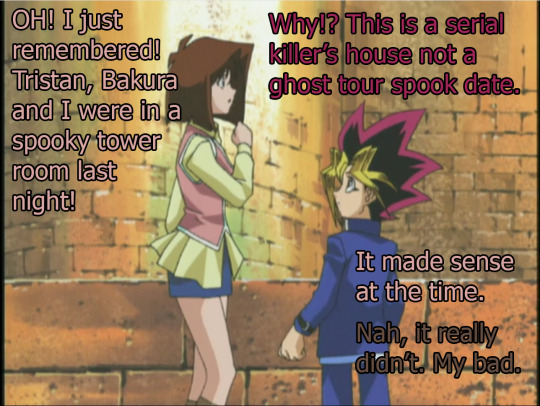
(Sometimes I get used to Yugi’s eyeliner and then they throw a shot like this at me and it’s like DAMN, Yugi, when did you have time to apply that stiletto heel to your face? Like most of the time I’m just put off by the awful hair and then the rest of the time I’m just really jealous of this emo boy’s wings.)
With that they suddenly remembered...the other stuff.
(read more under the cut)

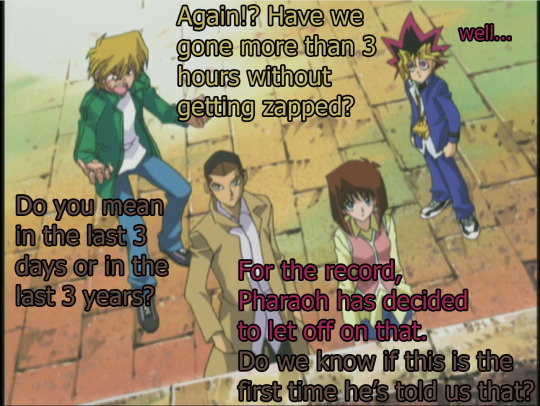
I like how Joey is just so incredibly fed up with magic at this point. Out of all of them, he seems to hate magic the very most although his best friend is a walking dark magic portal. Joey is just completely done, but unfortunately for Joey it turns out all the magic up to this point hasn’t even remotely been the amount of magic that this show is going to throw at us, because this entire episode is a bunch of wizards just screwing with each other.
I’ve mentioned before that it feels like the power players of Yugioh are kinda like Greek Gods where they just really can’t be bothered about 95% of the time--but when they are FINALLY bothered enough to move their own ass, they just kinda sweep the floor clean and leave me utterly baffled.
Anyways, Pegasus actually is in the spooky tower, to my disbelief, at this non-euclidean desk that doesn’t seem to exist in time and space.
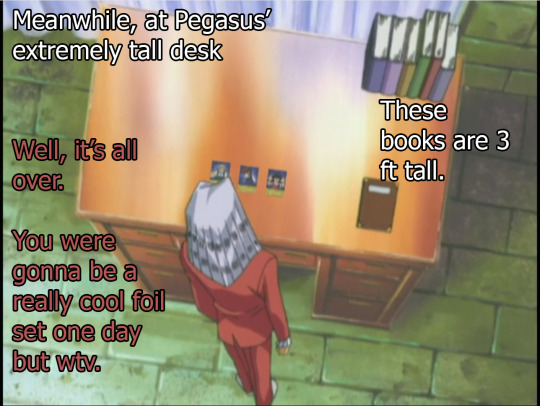
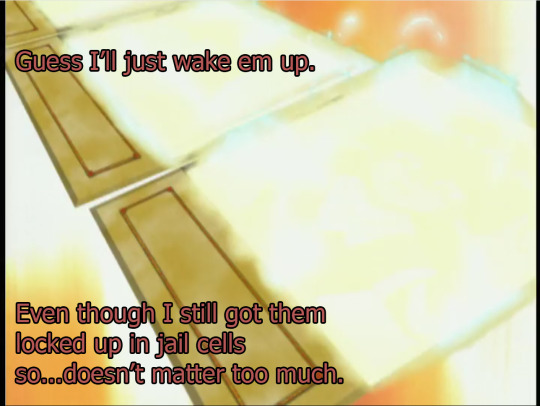
And then Kaiba wakes up in a cabbage-patch lookin jail cell. I would love to see more of his reaction to that but alas, this episode is not about Seto Kaiba.
Pegasus decided to make good on his word, mostly because Yugi is a cursed Pharaoh and he doesn’t want to see what happens if he doesn’t make his end of the bargain. To be quite honest, getting your mind scrambled would have probably been better than what did eventually happen to him in this episode.
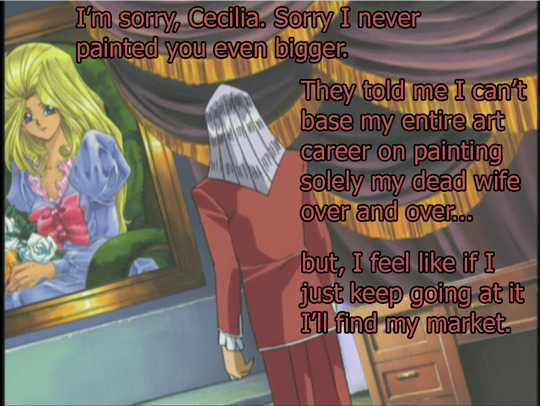
Seriously, did this guy ever sell a painting that wasn’t a card? His portfolio would just be one person. And they do say that you shouldn’t make your portfolio too many styles but, damn, you can’t just do one person, unless your going to work for one specific type of video game, in which case sure just draw that one space punk chick over and over it seems to work for you.

Bakura decides to show up, and he’s very Bakura about it, introducing a new Bakura mechanic that I didn’t at all predict would ever be a thing.

Bless this storyboarder.
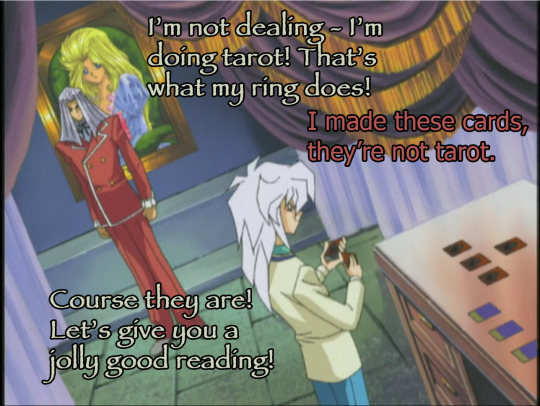
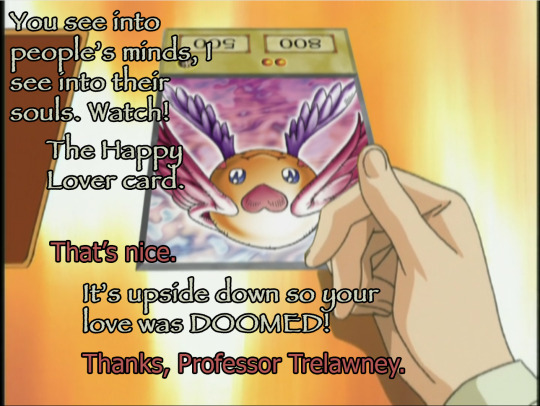
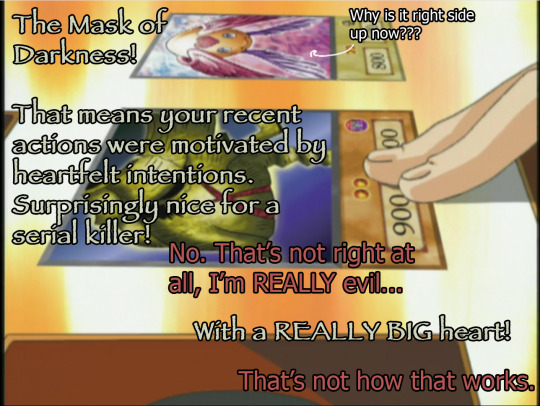

After showing off his weird tarot ability for no other good reason than to mess with Pegasus for a little bit, he decides to make me regret ever saying this necklace looked like it has five dicks.
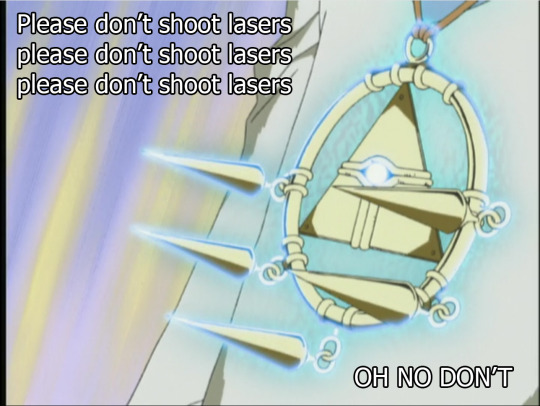
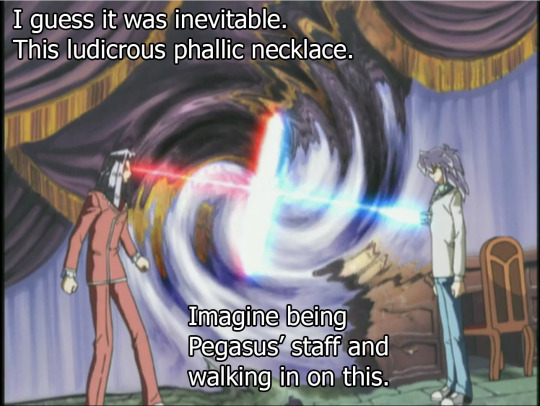
I am so sorry, I had no idea! I had no idea it would be shooting lasers! What the hell, show?? What genre am I even watching anymore??
Also this whole concept that at any point these items can just shoot anime lasers and start a...whatever this trope is called, is so bizarre to me. They CAN do this...but they prefer to use cards.
They CAN do this, at any point, but they prefer to trap the souls of you and your friends in a card so you must play even more cards.
Or they can shoot you with a laser and solve their problems that way.
But why would they? They can like...play cards and do tarot and read minds and make card monsters real so who would ever want to shoot freakin lasers!
I do appreciate that Pegasus’ laser is pink like the salmon I chose for his font.
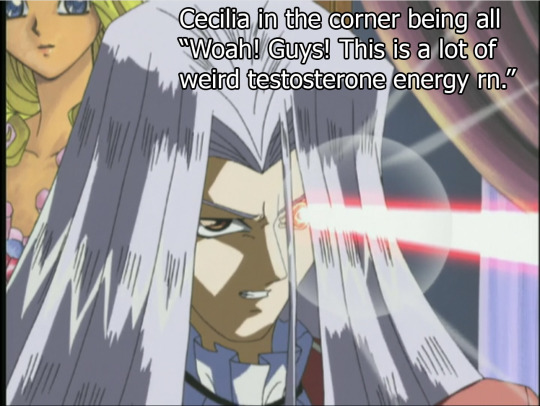
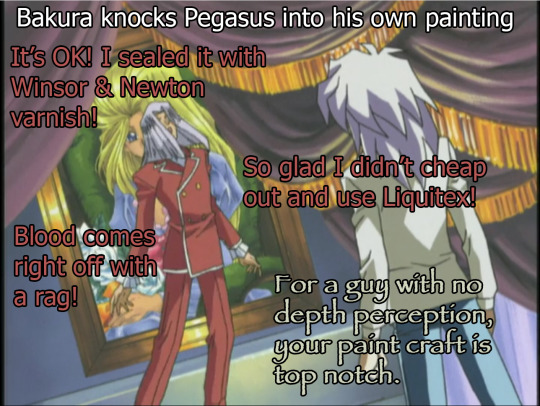
My bro argues that Pegasus probably sees just fine with the golden eyeball, but I feel like it can’t be the same, like a Spike Spiegal situation. It’s not like they ever tell us, anyway.
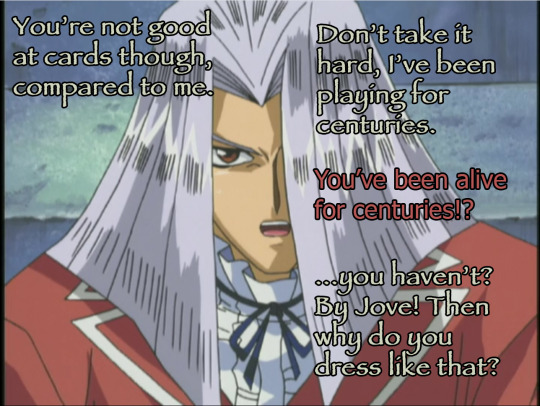
Him being alive for centuries is just never brought up for the rest of the episode. It comes up here and then Bakura’s like “Woopsie! Change the subject!”
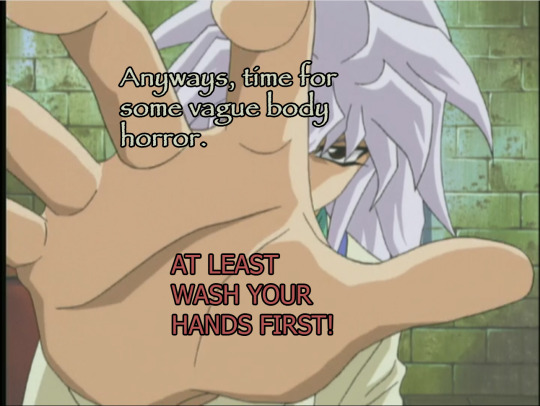
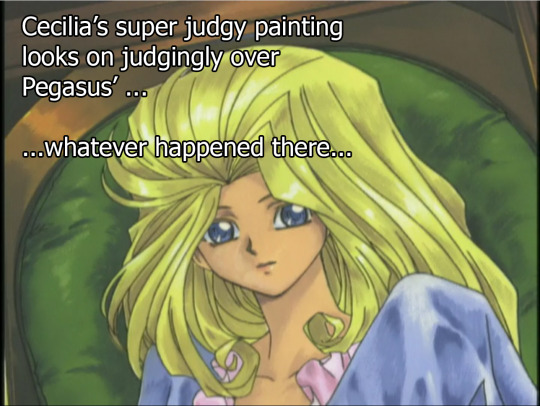
Kid’s show!
As a kid an episode of the Rugrats freaked me the hell out--you know the one where Reptar becomes alive? I couldn’t take that one, it was terrifying. So maybe I’m not one to judge, because I was not a normal kid when it came to anxiety (in fact a legit phobia of dogs gave me pretty severe panic attacks on a weekly basis) but, it seems like Yugioh is a lot like brother’s Grimm because they are SO READY to cut off body parts, revive corpses, and overall gross me out, just to make a point.
Is it necessary? Eh.
But is it bizarre body horror we can stuff in this kid’s story? YES LETS DO IT.
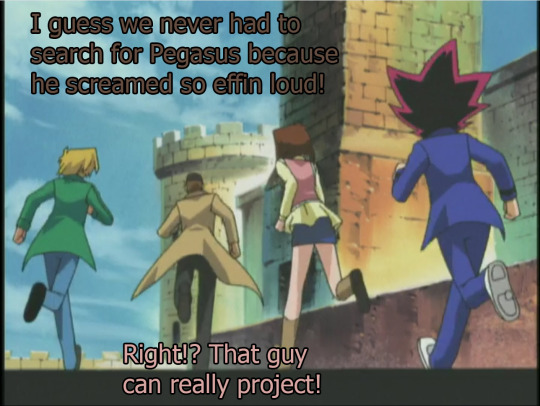
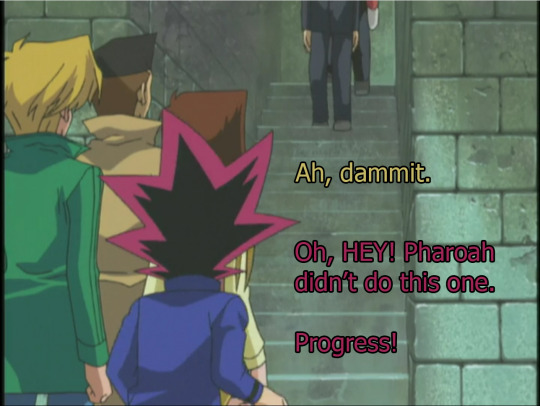
With the way they set this up it looked as if they were just going to have them show up in the nick of time or something, but instead the show was like “lol, these kids? You’re kidding, right?”

He’s literally missing an eye and Croquet’s exact line was something like “he’s fallen ill.”
Also, I’m glad we got a cameo from Double-Spike Mohawk Mullet Man in this episode, giving Pegasus a fireman carry like a trooper.

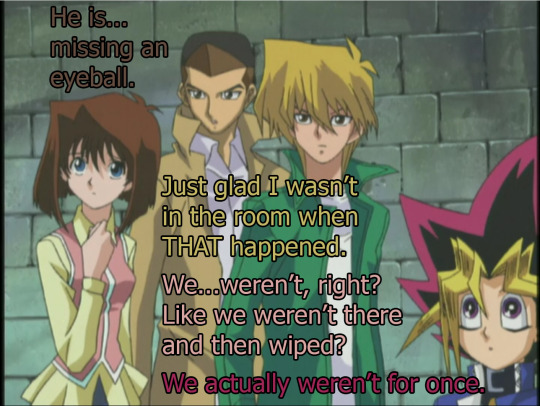
So, because they can’t not, and because Pegasus’ security is only effective at random times of the day (they must have a lot of smoke breaks or something) the four decide to raid Pegasus’ bedroom. Why would you ever want to do this to the guy who was ritually sacrificing people the night before!?

Joey’s weird crushes on blondes that are...not in High School. Joey. Stop this. You are a child.
Anyways, Tea goes straight for the juicy stuff, because if there’s anything in this world that I would never ever want to read is a grown man’s journal filled with all his unfiltered thoughts.
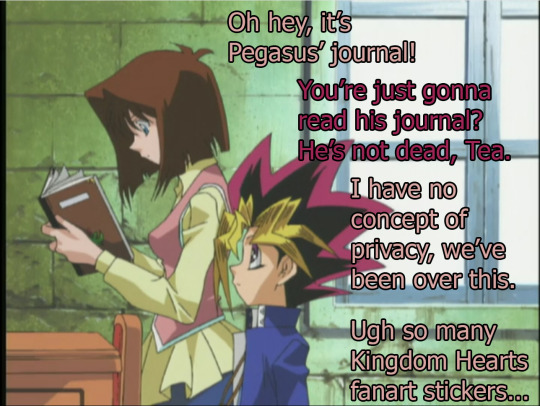
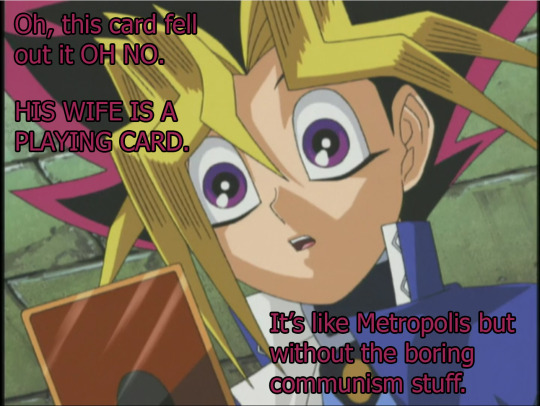
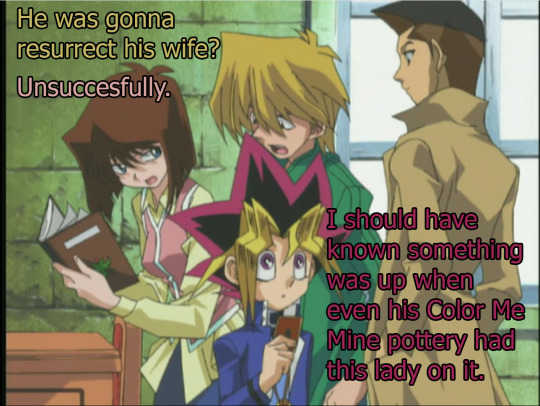

Then we’re welcomed into a Pegasus Flashback, because why not make a tragic past even more tragic? Anyways, it’s OK because anime food lives here.
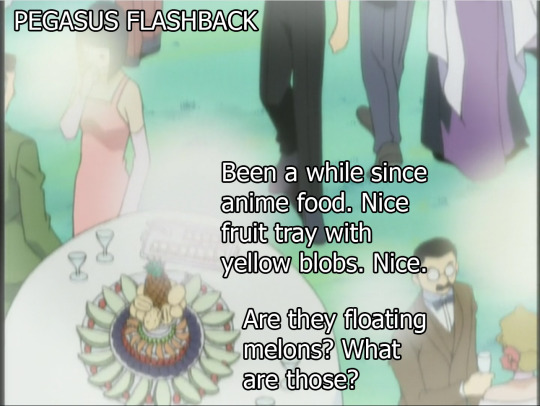
Bro called them gravity melons. I want to point out the party cups drawn from the side sitting on the round table we see from the top. Love it. Also realllllly love that guy with the mustache and glasses in the bottom right corner. There’s some good stuff here in this vaguely 80′s flashback.
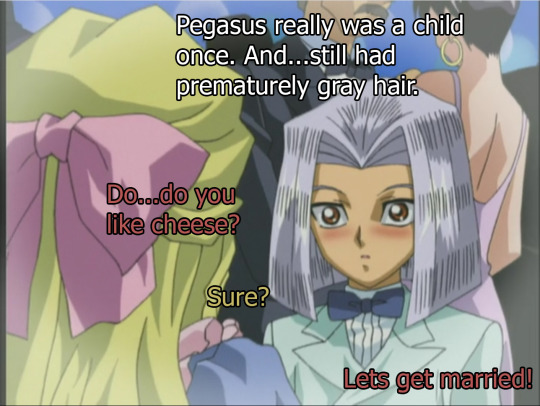

Anyway, she totally dies. The flashback goes through things we’ve been over before--they get married, she gets sick, she turns into a rose and then becomes a grave in a really poorly kept graveyard.
And so Pegasus turns to religion. Yes, you read that right, He decides, he wants to find a religion that will explain afterlife to him, and he’s like I might as well start with the oldest and work up, so he goes to Egypt.
Uh...OK. I mean if you’re just looking for a religion with an afterlife you could have chosen...almost any of them. You could have stayed in America and like gone to...anywhere but, the guy was like “Mummies, youknow?” and went to Egypt although Cecelia is already dead and buried so it’s not like he can do the mummy trick to her now. It’s a little LATE?
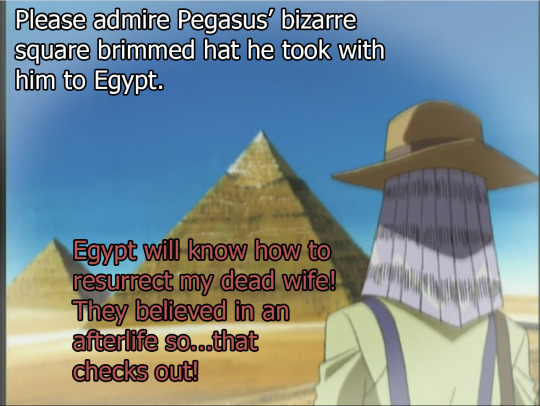
My brother and I were so entranced by this bizarre hat, that we wanted to see if it’s ever been made real. AND IT HAS.
MARVEL AT IT:

IT IS VERY EXPENSIVE.

LOOK AT THAT DUMB HAT!
We checked Amazon for cheaper listings, but only found trucker hats with the Square Mason symbol on it, and Illuminati trucker hats like this one.

My brother wrote this note to them. I hope they read it and take it to heart.
Anyways, our newly found joy, held aloft by the discovery of perfect square brimmed hats was quickly sullied.
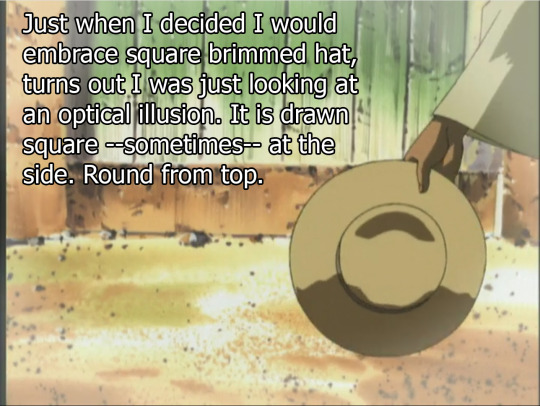
His hat is a transformer. But a round to square kind.
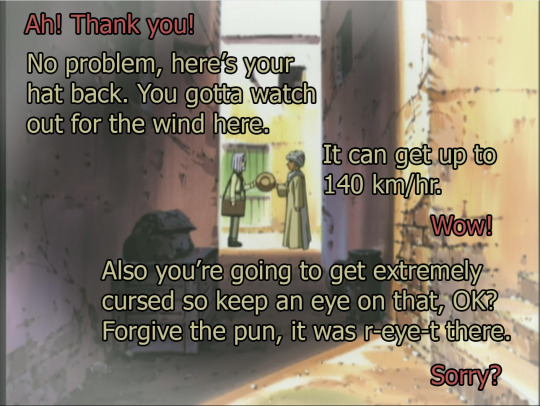
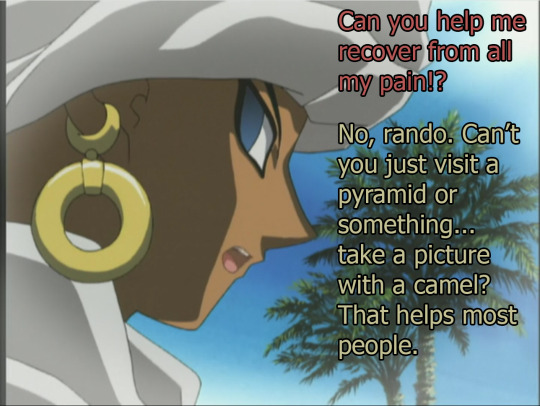
So in walks this guy. His name is Shadi. I’m telling you that right now because I want you to pay attention to how long it takes before we find out his name is Shadi. He is going to tell us his name at some point, and it’s very weird when it happens.
Pegasus doesn’t seem to realize it is not at all normal for a guy in modern Egypt to be walking around with this massive ankh on his chest (eh...you can’t see it in these pictures, but there’s a HUGE ankh just hanging around his neck) with earrings and pharaoh makeup. Pegasus is just that type of sheltered American. He’s like...well you look like someone from a movie so it must be legit. And that is how Pegasus decides to follow a guy who is clearly an ancient spooky wizard into an ancient death dungeon crypt.
I feel like Pegasus could have easily avoided this whole situation he got himself into.
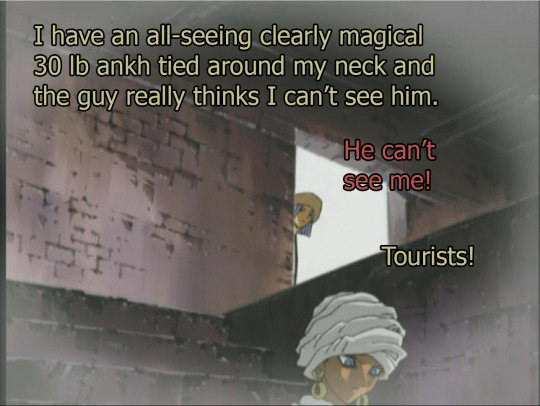
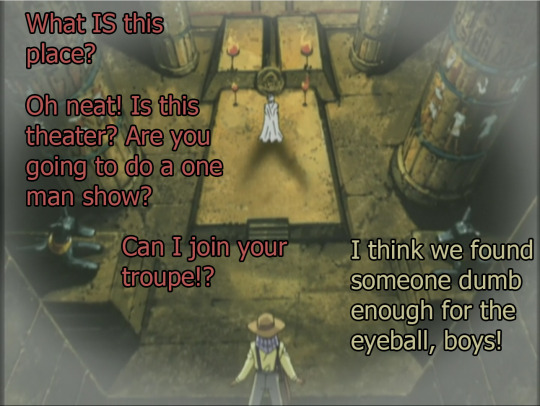
Shadi has a whole speech about how the eyeball has a lot of power, and that he’s got to protect it all yada yada--but at the same time Shadi is like “BUT I gotta make sure some people use it so a lot of terrible things happen. You’d think I’d just...leave this stuff in this crypt so it’ll never be a problem and the world will never be cursed with terrible dark magic that was sealed away for thousands of years, but...I’m gonna make it happen anyway...and it’s not my fault...”
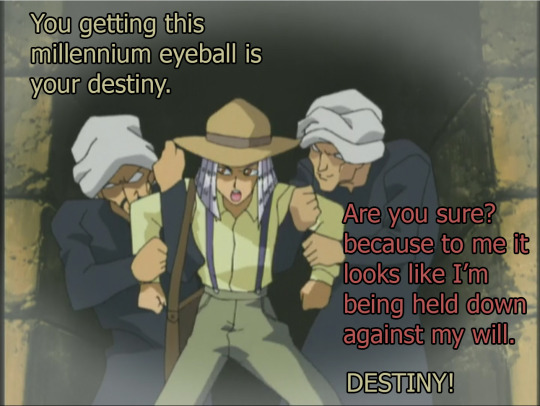
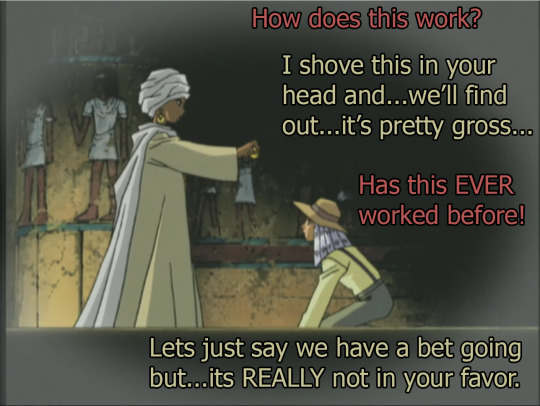
How many times has Shadi done this? It’s suggested that Pegasus is not the first.
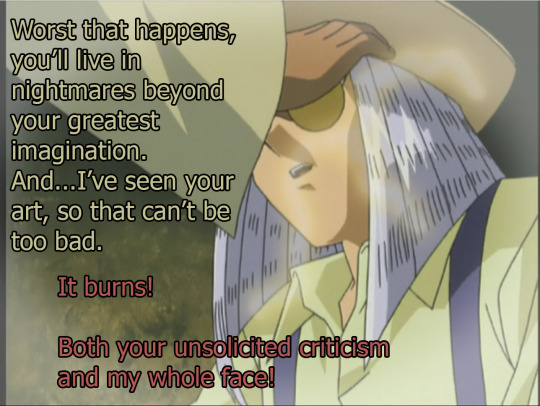
It’s pretty gross, and while it’s done in shadow (which was a nice visual allusion to Shadow Magic), it’s still pretty gruesome for a kids show. To happen twice in one episode of this kid’s show, haha.
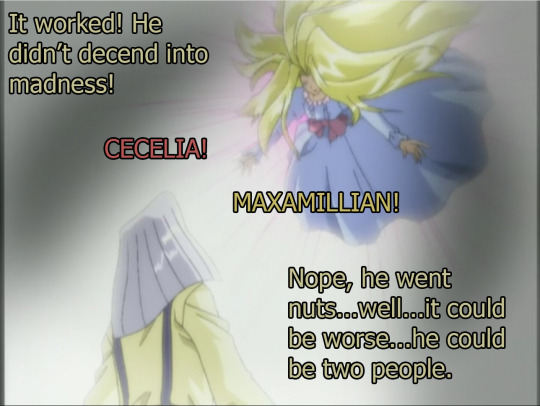
She calls him by his full name “Maxamillion” which made me realize he’s probably never shortened his name to “Max” in his entire life.
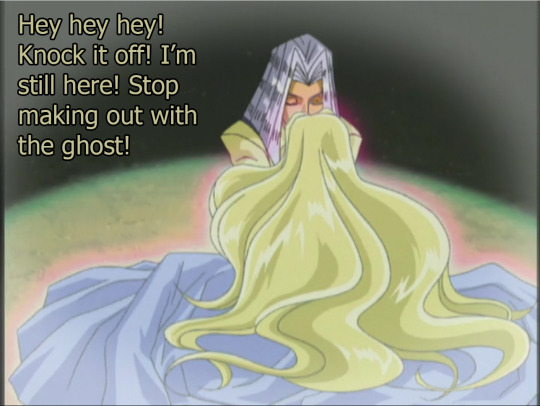
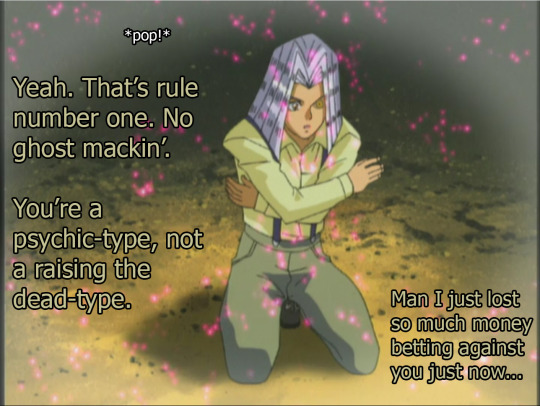
I’m glad Pegasus making out with a ghost happened on screen. This is now the most romance we’ve seen in all of Yugioh. Good.
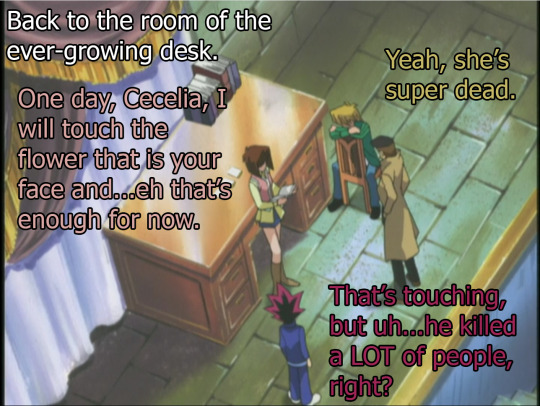
So did Pegasus actually write the part where he made out with a vision, though?
I’m curious about how that process works. But, I don’t think we’ll ever find out.
Anyways, next time, on this very same episode of Yugioh:
Will Bakura stick this eyeball in he own eye or will he back out last minute and just hang it from his necklace and pretend it was there the whole time? Will Tea next read Pegasus’ food diary only to discover, in horror, that he drank upwards 60 liters of grape juice and far exceeded his daily calorie intake? Will security even realize these children have been snooping in all of Pegasus’ personal stuff for the past 30 minutes?
#Yugioh#yugioh recap#photo recap#s1 ep40#tea gardner#yugi muto#tristan taylor#bakura#joey gardner#maxamillian pegasus#pegasus#cecelia#some weird psychic fight#with lasers#and then someones eye gets replaced on screen#square brimmed hat
25 notes
·
View notes
Text
When someone unexpectedly disappears online it can leave a lot of questions in the wake; what happened? Where’d they go? Will they be back? Luckily a paper trail isn’t as easy to pick up as it is to place down.

Long ago there was a person called “Meow” that was established in multiple social circles and numerous friendships. One day though they up and vanished. Nearly half a decade after their disappearance a group of past friends set out to discover what happened, where’d Meow go? Through multiple clues, look ups, and dot connecting the end result would lead to an unexpected but conclusive ending. So buckle up and get ready to chase a phantom with many faces.
Let’s go through some oddities and characteristics before we hop on the trail.
Meow’s Characteristics:
-was a fan of the Dark Souls series
-stayed up extremely late very often
-claimed to have residence in Ohio
-claimed to be mute and never spoke
-claimed to be female
-very into role playing
After the disappearance Meow’s a peculiar thing started to occur, some of Meow’s accounts started to delete. But not all accounts are deletable, like STEAM accounts. When Meow disappeared a new person claimed to have been the original owner that was lending it to Meow. They said Meow was doing other things now in life, that she was great and considering college again, and so on. That’s a nice ending to this all, perhaps Meow just was tired of the internet for whatever reason, left all her friends behind and is now socializing and partaking in greater activities. Aaaaaaand then the “original” owner removes all friends, privatizes profile and changes URL’s.

All’s well that ends well…
So let’s get started.
Friend#1 - Friend of Meow
Friend #2 - Friend of Meow
Friend #3 - Friend of Meow
Meow - A Ghost Themself
True Meow - ???
It started when Friend#1 and Friend #2 were discussing past times, past groups, past people… Meow? You remember that person? What do you think happened to them? And so curiosity was sparked.

Friend#2 remembers that when you gift someone on steam a gift a receipt of sorts is sent to the person being gifted. This receipt happens to include the email address of the person who sent the gift. Niiiice. It’s a start. The email address itself is a little odd, it is seemingly a random name with no numbers.
Googling the email gets nothing, well, almost nothing. Turns out the email address is 1 letter off from being a street name in Ohio, the state Meow had claimed to live. Alright, so why would you make an email after a street let alone use it to create a steam account?
Since googling the email wasn’t getting anywhere Friend#1 was about to give up on the search but a day later recalled that reverse email search engines exist.

Bazinga, a match.
There was an issue though. The site wouldn’t offer any more information than it had in the picture; a blurred photo and some odd censored name… Thanks too lazy programming though, we could go further. The blur filter over the image was only weakly applied. Right-clicking the image and opening it in another tab alone brought up the image without the blur filter. Google reverse image searching that picture also happened to result in a limited pool of unique hits, great. 3 out of 4 of the hits were from 4chan and the other was from a YouTube page, excellent.
Boy do things start getting wonky here.

The Youtube page had the exact same profile picture that the reverse email search had found so seemingly, this was the person except… the entire Youtube page was the polar opposite personality you’d expect Meow to have. Where Meow was known to be out spoken and kind, this profile was full of vulgarity and racism and bad memes, a huge contrast. To further add to the mystery, they had a Robloxs account linked to their profile.
What the fuck was going on, is this even the right person? How old are they? I had to make sure this reverse email search was accurate. I searched myself, I was found. I searched a friend, they were found. I searched another friend, they were found. Alright, three is enough. This search engine *seems* to work, unfortunately.
Looking past the /pol/ “humor” the Youtube profile’s “About” section had some further information. Supposedly they were from Greece and had a link to their Google+ account. And here’s where some connections start to be made. The Google+ account shows they’re not just into role playing themselves, it’s a huge past time to them! They’re a part of 5 role playing groups, from Five Nights at Freddy’s to Undertale to Half-Life, they’re all over. They’re even an admin of one of the role playing groups! They also happen to be into Dark Souls, so much so they’ve uploaded their own videos on it. What a coincidence.
Scrolling down the Google+ account, past the cringy roleplaying, past the racism, past the 12 year old humor and past the fucking Roblox we get a hit. A steam library screenshot and what lovely information we get.

Cue Friend#3!
Friend#3 enters the fray when I tell them of the search and how far I am. And they get down to business and get results fast. Friend#3 realizes the screenshot shows they use the Euro, it also shows their steam account’s username *which happens to be unique and very searchable* in the top right.
To try and cut a very, very long story short, this steam account username was the key that helped find nearly everything pertaining to this person;
-Facebook
-Soundcloud
-Flickr
-TripAdvisor
-Newgrounds
-Minecraft account
-Multiple rp forum accounts
-A Greek city public forum records
After we sifted through all of this we felt pretty confident this person was in fact “Meow”. Lets just label them “True Meow” for simplicity. True Meow likes to role play, maybe a little too much as he has at least 5 accounts all dedicated to different characters, he also tends to delete past accounts and history as we found out. Was it mentioned they’re a “he”? Well True Meow is a “he”. We never found pictures of specifically him but his sound cloud has very low view count songs of a male character with avatars he’s used on other sites. Presumably it’s him singing. He’s went to large extents to conceal his voice on his role playing accounts (unlike his Greek accounts), as in one of his Google+ posts he mentions he talks funny or sounds off. But this is likely just a ruse to hide his Greek accent and allow him to stay immersed as his, often female, characters. Even videos titled “Reading of xxx….” He specifically deleted as they probably contained his voice while keeping up non-voice related videos. We should also throw in he claims to be 26 two years ago but who really knows.
This Greek, role play loving, Dark Souls playing character seems to be the True Meow. But wait, there’s a cherry on top.

Googling Meow’s original alias long enough you’ll stumble onto an IRC log for UNIX support. Guess who is posting in the IRC asking for help? Someone under the alias “Meow”. They also happened to link a German language photo. (In case you’re worried that the photo is German and True Meow is Greek, True Meow’s TripAdvisor showed one logged trip, to Germany.) Why is this the cherry on top though? Because we had no hard similar links between Meow and True Meow, it was all relying on the reverse email search and common hobbies between the two. Thanks to Friend#3 though we found our True Meow posting a UNIX bug report on the same site but this time under his exact Greek name, True Meow.

“Coincidence? I think not!”
Now we had a connection that both Meow and True Meow were caught related to other than the email. With that I think we found what happened to Meow and ultimately one of the oddest cat fishing experiences.
Did we get the wrong person?
There was some things that favored Meow’s outrageous vanishing story, even with all this evidence:
1. Meow gave all of us a handful of free games over time while we gave nothing. Talk about a poor cat fisher if the goal was to get expensive things in return.
2. Keeping up appearances wasn’t cheap. Not mentioning the other games, Meow gave us all a Starbound key before the game released. That’s about $50 alone just to keep up kind appearances.
3. A point Friend#2 likes to argue, the contrast is simply too great. The belligerent, racist, unfunny True Meow is so unlike Meow that it’s unbelievable, even if it was a catfish that went on for months.
Was this just a dude that wanted to, for whatever reason, role play as a female was willing to lose money to do it? Or is this the wrong person? Won’t ever truly know for sure but I’m going with the strong evidence and multiple coincidences that Meow has indeed been found and the disappearance solved.
2 notes
·
View notes
Text
The illogic of a logical philosophy
The pilot episode of Star Trek: Discovery was titled “The Vulcan Hello,” and Michael Burnham was all about giving one to the Klingons.

Unfortunately, the Vulcan hello she was referring to looked a little less like this:

And a lot more like this:

Apparently, this shocked some fans, but I’m not really sure why. There are a lot of perpetuated ideas that Vulcans are strict pacifists because, after all, war is illogical. But if we really peel back some of the canon, the reality is that Vulcans probably prefer peace, but they’re certainly not above violence, and that’s the problem with living by logic.
Is violence illogical? Who’s to say? Even a philosophy based on pure logic is doomed to be convoluted because spoken language is imprecise and no philosophy is absolute. Yet Vulcan philosophy is often treated as though it must be, as if for any single issue, there is only one perfectly logical solution amid a sea of half-logical alternatives and utter irrationality.
So, what is Vulcan philosophy? Over the years, it’s expanded into a belief system that has two giant scoops of Greek stoicism, a pinch of Jewish mysticism, a dollop of utilitarianism, and a rationalism cherry on top. I would actually argue that this Frankenstein philosophy is whatever it needs to be, so long as it can be defended with a reasonably sound argument delivered in monotone, dispassionate speech. And therein lies the problem. How do we decide what is “reasonably sound?” Worse yet, what is logic?
Believe it or not, there is no universal agreement on the exact scope of this particular discipline. The ancient Greeks studied logic in philosophy, but logic also has more discrete applications in mathematics, computer science, and linguistics. I could type thousands of words dissecting the different branches of logic, but Wikipedia did it so much better than I ever could. Bottom line is, if you’re not using logic to defend mathematical proofs or write code, there’s a whole lot of gray area for what can be considered “logical.”

Me too, Amanda, me too.
So how do stoicism, rationalism, and utilitarianism fit into the Vulcan narrative? Stoicism goes back to the ancient Greeks and championed the idea virtue was based on knowledge, and that wise and virtuous people lived in harmony with reason and were able to accept reality and not allow themselves to be controlled by pain, fear, or desire. If that doesn’t sound like the first page of the Vulcan playbook, I don’t know what does.
Rationalism is a philosophy that sort of bridges ancient stoicism with the modern world and asserts that reason should be the chief source and test of logic rather than religious belief or emotional response. And lastly, utilitarianism is a doctrine that asserts that actions are right if they are useful or benefit a majority. Sound familiar?

If it doesn’t, you’ve never seen The Wrath of Khan. Or shopped at Hallmark.
But the thing is, not one of those philosophical systems says, “No violence.” If The Teachings of Surak has strict rules prohibiting violence, all the Vulcans we’ve ever met across six different series are really shitty Vulcans.
We see many instances of Vulcans preferring to avoid violence and killing—Vulcans often employ a nerve pinch to subdue aggressors rather than smack them around—but they are capable of worse. In the TOS episode, “Journey to Babel,” a Tellarite ambassador is murdered by someone who “knew exactly where to apply pressure to snap the neck instantly,” according to Dr. McCoy. As Kirk ponders who could have possibly committed such an act, Spock is all too quick to throw his dad under the bus and say, “Vulcans.”
While he quickly adds that “Vulcans do not approve of violence” he also mentions that “it would be illogical to kill without reason.” And so:

Backpedaling at warp eight.
Sarek knows how to kill because he’s skilled in a deadly martial arts technique called tal-shaya. The fact that Vulcans train in martial arts, possess weapons like the lirpa and the ahn-woon, and cruise around the quadrant in ships outfitted with weapons suggests they are at least prepared to defend themselves if necessary, which would disqualify them from being absolute pacifists. But that doesn’t necessarily make them warmongers either.
So, what about actually instigating a war? In Enterprise, we got a view of Vulcans that a lot of people weren’t comfortable with. We saw Vulcans spying on their Andorian neighbors, we saw religious factions fighting one another, and we saw a Vulcan High Command that seemed remarkably belligerent. Some fans might argue that after the discovery of the Kir’Shara in the Enterprise story arc that included the episodes “The Forge,” “The Awakening,” and “Kir’Shara” led to a new reformation, Vulcans returned to their true logical roots, ditching their semi-violent ways.
But it’s evident that Vulcans believe that sometimes logic requires violence. Recall those utilitarian principles woven throughout Vulcan philosophy. One of the most well-known philosophical thought experiments is referred to as The Trolley Problem, and it’s a test of utilitarian judgments. There are many variations, but the short one goes like this:
There’s a trolley hurtling down a track with five people on it. The brakes are shot and it’s going to crash, killing all on board. You happen to be standing next to a switch that would divert the trolley onto a separate track where it would gently crash into a sandbank, saving the lives of those five people. The only problem is, there is a person tied to the tracks you want to divert the trolley onto. If you pull the switch, you will actively kill one person to save five. If you do nothing, you will passively allow the person tied to the tracks to live at the expense of the five on the trolley. And so, if we are capable of acting, do we have a duty to act? (Here’s a fascinating quiz if you’d like to explore your own beliefs on the subject.) But what would Vulcans do?
Rather than spend time debating it, I can tell you exactly what most Vulcans would probably do. In the TOS episode, “Operation, Annihilate!,” Deneva colony is infested with neural parasites and Dr. McCoy can’t find a way to kill them. Kirk is struggling to find a way to prevent the spread of these parasites, and Spock points out the only logical solution, though it is “understandably upsetting,” is to destroy the colony and its one million inhabitants because there are billions of people living beyond Deneva colony to think about. McCoy didn’t handle it well.

A real dick move, Mr. Spock. A real dick move.
Now, to his credit, Spock was also infected, so he was willing to die for his principles, but he didn’t bat an eye at the idea of killing a million people. The good news is, it’s old-school Trek so of course they found a solution that didn’t end with the tragic slaughter of a million colonists, but Spock’s initial recommendation was that it was logical to commit an act of violence against one million people to save the lives of billions.
Maybe you agree with him, maybe you don’t, but that being said, is it really such a wild notion to believe that the Vulcans would prefer occasional small acts of aggression against the Klingons if there were sufficient reason to believe it would prevent a war?
When explaining to Captain Georgiou what a Vulcan hello was, Michael Burnham didn’t say the Vulcans slaughtered every Klingon they encountered, simply that they “fired first” in order to “say hello in a language the Klingons understood.” If anything, it sounds like the Vulcan policy was more in line with a warning shot than a Klingon genocide, and from my own simple-minded human perspective, that sounds pretty damn logical if it prevents real and prolific bloodshed.
But that comes back to the initial question of “what is Vulcan philosophy?” Perhaps we should ask ourselves who is the ultimate judge of what is logical? In theory, it should be Surak and his teachings, right?

Surak’s a smart guy who obviously knows a bargain when he sees one, as illustrated by this ensemble that looks a 6th grade home economics project met the clearance rack at the local craft store.
Unfortunately, just because something is written down doesn’t mean everyone is going to agree on the same interpretation, otherwise, the U.S. Supreme Court would be about 99% less busy and history wouldn’t be littered with the bodies of billions of people desperate to prove their version of the God of Abraham is the right one.
I don’t know why Vulcans are so often portrayed as being a culture of homogenous personalities, beliefs, and values, as though logic is logic and there’s no room for variation. Imagine what the series would have been like if we played switcheroo with Spock, Tuvok, and T’Pol. Picture the moody and somewhat emotional T’Pol trying to give advice to Captain Kirk, or the wise and experienced Tuvok trying to talk Archer out of half the shit he did in the Delphic Expanse.

Tuvok’s eyes are clearly asking if it’s too late to go back to the Delta quadrant and get assimilated by the Borg.
The point is, individual Vulcans aren’t interchangeable, and I don’t think their beliefs are either. Just look at what happened in the Enterprise episode, “Carbon Creek.” Three Vulcans are marooned on Earth in the 1950s and are facing starvation when they encounter a pair of deer. Despite the fact that Vulcans eat plant-based diets because their tenets about non-violence extend to animals, Mestral suggests eating one of them because:
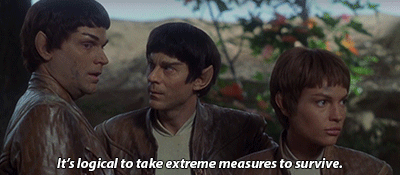
A Vulcan Mrs. Donner.
Stron is Vulcan-horrified at the idea of resorting to “savagery,” but thankfully T’Pol/T’Mir agrees to violate the Vulcan version of the Prime Directive instead so they don’t have to murder Bambi’s mom. But that scene raises an interesting point. Who was right, Mestral or Stron? Or both? Or neither?
Put 100 Vulcans in a room and ask them when war is justifiable, I’m sure they’d all spout off some Vulcan version of Just War Theory like the smug, walking information databases that they are. But put 100 Vulcans in charge of making a real-world decision about going to war, and we’d get 100 different answers, some which directly contradicted others, but each defended by iron clad logic.
To wrap this drivel up, Vulcan philosophy is a really bizarre hodgepodge of conflicting ideologies. They believe in infinite diversity in infinite combinations, which means they celebrate the beauty of the countless variables of the universe, unless it’s a Klingon bird-of-prey, in which case, they shoot that shit up. Pacifism is great when it’s convenient, killing is bad, except for when it isn’t, it’s not genocide if you have a really good reason, and eating animals is wrong, except for when it’s necessary. Yeah, logical.
I’m of the opinion that Vulcans are no better than humans—they do their best to grapple with complex issues according to a chaotic and occasionally contradictory set of beliefs. Even if they swear they aren’t driven by emotion, they are still at the mercy of their life experiences and world views when it comes to decision making. Logic is a tool that can help them arrive at answers, but it isn’t the answer. Most importantly, like any tool, logic can be abused or corrupted.
Given the weight of the evidence, I would re-assert that Vulcans are happy to declare anything as being logical, so long as it suits their agenda or personal beliefs. Or perhaps it’s better to say that the writers of Star Trek will call anything logical if it adds to the dialogue or advances the plot.
What say you, T’Pol?

#star trek#star trek discovery#star trek enterprise#star trek the original series#vulcans#vulcan philosophy#spock#t'pol#tuvok#meta#long post#live long and prosper
191 notes
·
View notes
Text
Matthew 5:43-48 Commentary
Introduction
The Sermon on the Mount has had a profound impact on both Christians and non-Christians throughout the centuries. Mohandas Gandhi “was profoundly influenced by this Sermon as he established India’s freedom through a nonviolent revolution.”[1] For Martin Luther King Jr., the Sermon on the Mount served as the foundation for his political program and unwavering commitment to nonviolent, civil disobedience.”[2] The original audience also marveled at the power of Jesus’ words. Matthew 7:28-29 reads, “When Jesus had finished saying these things, the crowds were astonished at his teaching, because he was teaching them like one who had authority, and not like their scribes.” In a day when Jesus is perceived as a “nice guy” who proclaimed some useful ethics, this response can be appreciated, for they affirmed that His words were as powerful as His works. However, such a response ultimately misses the mark. Anyone who reads the gospels should be amazed at the power and authority of Jesus’ words, amazement is not the same is acceptance. “Amazed” in the Greek does not denote saving faith.[3] Amazement should occur, but the goal is discipleship – submission to The Amazing One. Those who fail to move from amazement to discipleship have yet to through the narrow gate, which means that they are in danger of hearing those dreadful words from Jesus: “I never knew you. Depart from me, you lawbreakers!” (Matt 7:23b). With Matthew 7:43-48 as the focal point, this paper will seek to highlight the amazing power and authority of Jesus’ teachings, but will also seek to show how His speech actually points to Him as the authoritative Son of God who should be obeyed. First, however, some general comments must be made about the context in which this passage finds itself.
The Sermon on the Mount (Matthew 5-7)
One of the key themes in Matthew’s gospel is the idea that the coming of Christ has inaugurated the kingdom of God on earth. Matthew 4:17 reads, “From then on Jesus began to preach, ‘Repent, because the kingdom of heaven has come near.’” Then, in 4:18-22, Jesus commissioned His first disciples. 4:22-25 documents Jesus’ teaching, preaching, and healing ministry in Galilee. The Sermon on the Mount is a sample of the kind of teaching Jesus presented and details the life experienced inside the kingdom that has just been inaugurated by Christ.
Matthew is particularly interested in Jesus’ teachings. That is not to say that the other gospel writers are unconcerned with His words, for they all record teachings from Jesus and conversations He had with individuals and groups. However, a large portion of Matthew’s gospel is devoted to Jesus’ words, ultimately providing the reader with 5 lengthy discourses (5:1-7:29; 10:1-42; 13:1-52; 18:1-35; 24:1-25:46). Preaching was a regular part of Jesus’ ministry. There were at least two times during His ministry that He preached to the multitudes all day (14:13-21; 15:32-38). Matthew concludes with the Great Commission (28:20), in which Jesus exhorts the disciples to teach all that He has commanded them. The blueprint for this instruction is found in the discourses. Thus, gospel readers should marvel at Jesus’ words, but ultimately His words are to be obeyed and taught.
Unfortunately, many people who heard Jesus’ words never moved from admiration to discipleship. The imperfect tense of the verb translated “were amazed” “depicts an ongoing feeling of wonder as they went home.”[4] Jesus’ words should have prompted the crowds to follow after Him, not return home. The Sermon on the Mount was not the only time that Jesus’ words prompted feelings of awe and wonder. Matthew 13:54 reads, “He went to his hometown and began to teach them in their synagogue, so that they were astonished and said, ‘Where did this man get this wisdom and these miraculous powers?’” Matthew 22:33 records that “When the crowds heard this, they were astonished at his teaching.” His disciples, too, continued to be astonished at His words even after conversion (Matthew 19:25).
Part of the reason the crowds were particularly amazed at Jesus’ Sermon on the Mount is because He was so unlike the scribes that they were used to (7:28). The scribes were the legal experts, lawyers, and teachers (2:14; 5:20). The Talmud explains that their habit was to repeat earlier teachings. Jesus did not depend on the teachings of man. “His teaching ‘fulfilled’ Torah and lifted it to a higher plane.”[5] Wilkins explains that the authority of the religious elite “came from their expertise in citing earlier authorities and in formulating new interpretations. But ironically, their practices had muted the authority of the Old Testament because they added so many traditions and legal requirements that the power of Scripture was defeated (e.g., 15:1-9). Thus, they could not speak with authority, for they had muted the only source of authority.”[6] So when Jesus came on the scene, they immediately recognized that He was not like the religious leaders. The contrast between the scribes and Jesus is seen very clearly in the six antitheses.
The Six Antitheses (5:21-48)
In order to feel the full force of Jesus' words here, one must know something of the religious climate of the day. The religious leaders “held sway over the lives of the common people.”[7] The Pharisees had had essentially devised a religious system that called for a legalistic obedience centered on external behaviors but was unconcerned with the heart. They presented themselves and righteous and called others to be righteous, but Jesus described them as “whitewashed tombs, which appear beautiful on the outside, but inside are full of the bones of the dead and every kind of impurity” (Matt 23:27b).
Thus, while Matthew 5:21-48 is commonly known as “the antitheses” it is not because Jesus contradicts the Old Testament itself; after all, He came to fulfill the Old Testament, not abolish it. The problem rests not with Scripture, but with the intent and motives of those who claimed to follow God. Therefore, He exposes the misinterpretations and misapplications that were so prevalent and pervasive in His day. Here, then, Jesus reveals the true nature of the Old Testament and lays bare the errors of the ones who were supposed to be the Old Testament experts.[8]
“You have heard it said…” (v. 43)
There are two common phrases that are joined with each antithesis. The first is “You have heard that it was said.” The verb translated “was said” points to God as the Divine Author relaying His message to the human author, who in turn communicated the message to God’s people.[9] Six times Jesus in 5:21-48 Jesus uses this phrase, and each time it is followed either by an Old Testament quote or a common saying propagated by the teachers of their day.[10]
The first five antitheses deal with murder, adultery, divorce, oaths, and revenge. The sixth one deals with love – and in reality, all six are a love issue. This final antithesis, then, ties all six together and demonstrates that love is the key issue. This sixth and final time, He says, “You have heard that it was said, ‘Love your neighbor and hate your enemy.’” The first part of this phrase comes directly from the Pentateuch. Leviticus 19:18 reads, “Do not take revenge or bear a grudge against members of your community, but love your neighbor as yourself; I am the Lord.” In Deuteronomy 6:4-5, the Israelites are commanded to “ Love the Lord your God with all your heart, with all your soul, and with all your strength.” But the second part is not found in the Old Testament. Some scholars think that this attitude can be inferred from certain Scripture passages – specifically Deuteronomy and Psalms. For example, Deuteronomy 7:2 says, “When the Lord your God delivers them over to you and you defeat them, you must completely destroy them. Make no treaty with them and show them no mercy.” In Psalm 139:21-22, David says, “Lord, don’t I hate those who hate you, and detest those who rebel against you? Hate them with extreme hatred; I consider them my enemies.” Further, some believe that the imprecatory Psalms endorse and attitude of hatred towards one’s enemies.[11] However, Moses explicitly told the people to help enemies who are in need in Exodus 23:4-5: “If you come across your enemy’s stray ox or donkey, you must return it to him. If you see the donkey of someone who hates you lying helpless under its load, and you want to refrain from helping it, you must help with it.”
God does hate evil (Deut 30:7; Ps 4:5; 5:4: 139:21-22) but loves reconciliation. Christ’s atonement ensured salvation for those who were dead in trespasses and enemies of God. The Israelites were to be a light in the darkness to surrounding pagan nations so that they too might be reconciled to God, but they instead adopted a feeling of superiority as God’s chosen people. Thus, their pride resulted in an unrighteous hatred of others. They were the trusted sources, yet they failed to interpret Scripture properly.[12] True disciples are called to be like God. Therefore, disciples are to hate evil (including the evil inside their own hearts!) but love their enemies.[13]
Jesus then shows them how the understanding that they are holding to is leading the people to wrongly apply God's Word. The scribes and Pharisees lacked love for God and love for people, while Christ possesses a perfect love for the Father. His atonement enables His to love like they should, and His teachings that are recorded in the gospels provide the specifics on how to express this love.
“But I say to you…” (v. 44)
The second phrase is “but I tell you,” and It is here that Jesus' directs their respective paths. This phrase points to the authority and deity of Jesus and shows how the understanding that His audience holding to is leading to a wrong application God's Word. The scribes and Pharisees lacked love for God and love for people, while Christ possesses a perfect love for the Father. His atonement enables His disciples to love like they should, and His teachings that are recorded in the gospels provide the specifics on how to express this love.
Unlike the scribes and Pharisees, Jesus did not merely quote other religious leaders, but spoke in such a way as to elevate His words to be on par with the Old Testament Scriptures. Blomberg writes, “Such preaching reflects either the height of presumption and heresy or the fact that he was a true spokesman for God, whom we dare not ignore.”[14] In reality, He was not a heretic but the Holy One who spoke Scripture into existence just as He spoke all of creation into existence. To be sure, He quoted the Old Testament in a way that showed that He was grounded in God’s Word, but He expounded on it without a dependence on others. Jesus’ authority is inherent, not derived. The Old Testament prophets would speak powerful messages, but their words would often be prefaced with the phrase “Thus says the Lord.” Jesus did not preface His teachings like this because He is the Lord. Thus, He placed His teachings on par with the Old Testament, thereby showing that His words are divine.[15]
The command to love one’s neighbor here is in the present imperative, “Stressing the ongoing need of such am attitude.”[16] The word translated “love" has a wide range of meaning depending on its context. Several commentators have offered up definitions for this particular context. According to Wilkins, love is “an unconditional commitment to an imperfect person in which I give myself to bring the relationship to God’s intended purpose.”[17] As defined by Carson, it is “generous, warm, costly self sacrifice for another's good.”[18]
There are 2 words here in particular that show how Jesus elevated love, and therefore the standard of perfection. The first is the word “enemy.” In verse 43 it is in the singular, but here it is in the plural, meaning that this is a universal command.[19] In other words, all who could be considered enemies are to be loved in this way. Leviticus 19:33-34 says, “When an alien resides with you in your land, you must not oppress him. You will regard the alien who resides with you as the native-born among you. You are to love him as yourself, for you were aliens in the land of Egypt; I am the Lord your God.” Luke 6:27-28 – a parallel passage – makes 2 additions: disciples are to do good to those who hate them, and bless those who curse them. Why should disciples love to such a degree? What is the basis for such love? Jesus answers that question next.
Rationale (v. 45)
Here, Jesus gives two reasons that disciples should love even their enemies. The first is “so that you may be children of your Father in heaven.” This is not describing the means by which one becomes a Christian; one will know a disciple by their fruits (Matt 7). This concept is more fully developed as time goes on and the New Testament is written, but this kind of love is made possible when a person becomes a child of God and is given the Holy Spirit who enables believers to live righteous lives – something they could never accomplish on their own.[20]
Wilkins notes that “the inauguration of kingdom life does not enable Jesus' followers to obey merely the externals of God's commands, but it wakes them to the very core of the Old Testament's intent and motive so that they can obey God's will for the heart.”[21] On their own, humans lack the capacity to love as they ought, but when one becomes a disciple of Christ, he is enabled to do so because the infinite, loving God equips them to do so. Along these same lines, Wilkins writes, “God is love, and he is infinite, so he has an infinite supply of love. As we open our hearts to him, his love pours into our hearts and then overflows to those around us.”[22]
The second reason is that “he causes his sun to rise on the evil and the good, and sends rain on the righteous and the unrighteous.” God is no respecter of persons. He bestows His common grace on all of mankind. If God can care for even the most vile man on the planet in this way, disciples can certainly follow that example.
Rhetorical Questions (vv. 46-47)
Next, Jesus illustrates His point with 4 rhetorical questions: “For if you love those who love you, what reward will you have? Don’t even the tax collectors do the same? And if you greet only your brothers and sisters, what are you doing out of the ordinary? Don’t even the Gentiles do the same?” Essentially, all four of these questions drive the same point home: even those that society deems the least likely to show love actually cares for those who are like them. Tax collectors were allowed to collect more than the necessary amount for taxes and pocket the extra change.[23] And yet, in spite of their unethical practices, even tax collectors would care for those who loved them. Likewise, tensions between Jews and Gentiles ran high. The Jews were known for being circumcised. Most Romans and Greeks found the procedure not only unnecessary, but detestable. Josephus recounts how Gentiles would mock and ridicule Jews because of their circumcision.[24] However, what could be said about the tax collectors could be said about Gentiles: though they were regarded as selfish, unclean, unloving people, they nevertheless cared for those close to them.
The love shown by disciples of Christ is to exceed this minimalistic display of love. Plummer writes, “To return evil for good is devilish; to return good for good is human; to return good for evil is divine.”[25] Jesus showed this “divine” aspect as He elevated love in a way that was unheard of at that time – certainly in a way that was not taught by the scribes and Pharisees. The religious leaders focused on external actions. Being a disciple begins with the heart, which in turn manifests itself in proper external actions. That is the reality of kingdom life.[26]
Greeting someone in this culture was more than a simple “hello.” This was an expression of one's heartfelt desires for his enemies' well-being.[27] The greeting a person received showed their status.[28] Scribes swooned at eloquent, verbose greetings. In Jesus’ own words, “They love the place of honor at banquets, the front seats in the synagogues, greetings in the marketplaces, and to be called ‘Rabbi’ by people” (Matt 23:6-7). Such care should be given even to enemies. Blomberg rightly points out that “people who love and greet their enemies and pray for their persecutors thus prove themselves to be those…who are growing in conformity to the likeness of their Heavenly Father.”[29]
The Bottom Line: Be Perfect (v. 48)
This verse serves as a fitting conclusion not just for verses 43 through 47, but for all six of Jesus’ antitheses. Additionally, the word “therefore” actually points to this verse as a summation of verses 21 through 47, even though the sermon carries on for 2 more chapters.[30] The word translated “perfect" means “to be mature or whole.” The word “perfect" (Gk. teleios) is also a reflection of the Hebrew tamîm, which normally referred to a sacrifice without blemish.[31]
What Christ is calling for is an ethical and moral perfection.[32] Walvoord notes that “while sinless perfection is impossible, godliness, in its biblical concept, is attainable.”[33] It is frequently the case in Greek that the tense of a verb affects the meaning of the verse in which it is situated, and that is certainly the case here. This is a future indicative,[34] denoting that disciples are to strive for this for the rest of their lives. Though they cannot be perfect in their own strength and volition, Morris comments that “Jesus puts His command in such a way that disciples may look for divine help as they press toward God's goal for them.”[35]
This command cannot be viewed rightly apart from the qualifying phrase “as your heavenly Father is perfect.” The Bible is a reflection of God himself,[36] and the disciple must study it in order to learn who God is so that He may worship Him rightly and grow towards this perfect standard. A distinction must be made between God’s communicable attributes and His incommunicable attributes. Disciples are finite creatures and cannot possess the attributes of omniscience, omnipotence, and omnipresence. Again, the disciple is to pursue moral and ethical blamelessness – in a word, holiness. As the disciple, looks to the Bible’s depiction of God’s character, he will learn that God “has every good and admirable quality to the highest degree”[37] and that “His perfection is the goal for our thoughts and actions, for our relationships inside and outside the community.”[38] Indeed, “He embraces every degree of every perfection without any limitation.”[39] Though God has incommunicable attributes that He shares with no other being, His communicable attributes are reflected in His children. Disciples are neither called to simply be better versions of themselves, nor to be like another more mature discipline in their midst. Rather, they are to be like God. His ways are to permeate the minds of disciples, as well as shape their affections and dictate their actions.
And yet, one feels a great tension in this command. If one is to be perfect, how can anyone be a true follower of Christ? While this takes a conscious effort on the disciple’s part, it is only made possible by the atonement of Christ.[40] The doctrine of propitiation is not unpacked here, but New Testament disciples understand – especially with the help of the apostle Paul – that God made Christ a propitiation on our behalf (Romans 3:21-26) with the end result being that those in the crowd (in a manner of speaking) would become disciples by way of Christ’s righteousness being imputed into their account (cf. 2 Cor 5:21). Therefore, the perfection spoken of by Christ is only made possible by Christ Himself.
Conclusion
The miracles performed by Jesus demonstrated His deity and pointed to the fact that He was (and is!) the promised Messiah spoken of in the Old Testament. All too overlooked are the power of His words, as they are often viewed as mere ethical statements that will enhance a person’s life if they are carefully considered. As has been shown above, the words of Christ demonstrated His Messiahship just as much as His miracles did. His words demonstrated that He was steeped in Old Testament knowledge. Though the scribes and Pharisees were well-studied, they had interpreted and applied the law incorrectly. Jesus showed the true nature of the Law, and in doing show showed that His words were authoritative. These words that were recorded by Matthew carry just as much weight today as they did then. Followers of Christ are to not only marvel at these words, but should also obey these words, confess Christ as the promised Messiah who demonstrates His lordship through the power of His words, and teach them to all who would follow after Christ.
Bibliography
Beeke, Joel. A Puritan Theology: Doctrine for Life. Grand Rapids, MI: Reformation Heritage, 2012.
Beeke, Joel. Reformed Systematic Theology. Wheaton, IL: Crossway, 2019.
Blomberg, Craig. The New American Commentary: Matthew. Nashville, TN: Broadman & Holman, 1992.
Broughton, Geoff. "Interpretative strategies for Jesus' 'Sermon on the mount' (Matthew 5-7)." St. Mark's Review, No. 227, (Feb 2014). 21-30. https://search-informit-com- au.ezproxy.liberty.edu/documentSummary;dn=207860610991086;res=IELHSS. Accessed August 6, 2020.
Cousland, J. R. C. The Crowds in the Gospel of Matthew. NovTSup 102. Leiden: Brill, 2002.
Edwards, Richard A. Matthew’s Narrative Portrait of Disciples: How the Text-Connoted Reader Is Informed. Harrisburg, PA: Trinity Press International, 1997.
Elwell, Walter (ed.). Evangelical Dictionary of Theology. Grand Rapids: Baker 2001.
Frame, John. Systematic Theology: An Introduction to Christian Belief. Phillipsburg: P & R Publishing, 2013.
France, R.T. Tyndale New Testament Commentary Series: Matthew. Nottingham: Inter-Varsity Press, 1985.
Gladstone, Matthew. Murder, Anger, and Altars: The First Matthean Antithesis in Light of Exodus 21:14 and its Early Rabbinic Interpretation. Novum Testamentum, Volume 59: Issue 4, 339-354. https://doi-org.ezproxy.liberty.edu/10.1163/15685365-12341576. Accessed August 6, 2020.
Grudem, Wayne. Systematic Theology: An Introduction to Biblical Doctrine. Grand Rapids: Zondervan, 1994.
Hagner, Donald. Matthew 1-13. WBC 33A. Dallas: Word, 1995.
Jones, Matt. "The Sermon on the Mount and Human Flourishing: A Theological Commentary." Journal of the Evangelical Theological Society 61, no. 2 (06, 2018): 387- 9,http://ezproxy.liberty.edu/login?qurl=https%3A%2F%2Fsearch.proquest.com%2Fdocvi ew%2F2109282031%3Faccountid%3D12085. Accessed August 6, 2020.
Kittel, Gerhard, Gerhard Friedrich, and Geoffrey W. Bromiley (eds.). Theological Dictionary of the New Testament. 10 Vols. Grand Rapids: Eerdmans, 1964.
MacArthur, John and Richard Mayhue Biblical Doctrine: A Systematic Summary of Biblical Truth. Wheaton, IL: Crossway, 2017.
Osborne, Grant. Zondervan Exegetical Commentary on the New Testament: Matthew. Grand Rapids, MI: Zondervan, 2010.
Viljoen, Francois P. Jesus' teaching on the Torah in the sermon on the Mount. Neotestamentica, 40 no 1 2006, p 135-155. https://web-b-ebscohost com.ezproxy.liberty.edu/ehost/detail/detail?vid=0&sid=b5ab66f4-5dfa-432e-8a83- fbb0b31d5f40%40pdc-v- sessmgr03&bdata=JnNpdGU9ZWhvc3QtbGl2ZSZzY29wZT1zaXRl#AN=ATLA000155 1812&db=lsdar. Accessed August 6, 2020.
Viljoen, Francois P. “Righteousness and identity formation in the Sermon on the Mount.” HTS Theological Studies, No. 1 (2013). 1-10. https://doaj.org/article/22b3cff4749e4bd3b2fdb7202dcab552. Accessed August 6, 2020.
Wilkins, Michael. The NIV Application Commentary: Matthew. Grand Rapids, MI: Zondervan, 2004.
[1] Wilkins, Michael. The NIV Application Commentary: Matthew (Grand Rapids, MI: Zondervan, 2004), 190.
[2] Ibid.
[3] Ibid., 328.
[4] Osborne, 276.
[5] Osborne, Grant. Zondervan Exegetical Commentary on the New Testament: Matthew (Grand Rapids, MI: Zondervan, 2010), 277.
[6] Wilkins, 328.
[7] Ibid., 241.
[8] Ibid., 240.
[9] Ibid., 241.
[10] Ibid.
[11] Osborne, 212.
[12] Blomberg, Craig. The New American Commentary: Matthew (Nashville, TN: Broadman & Holman, 1992), 114.
[13] Wilkins, 252.
[14] Blomberg, 134.
[15] Wilkins, 240.
[16] Osborne, 212.
[17] Wilkins, 266.
[18] Osborne, 212.
[19] Ibid.
[20] Wilkins, 253.
[21] Ibid., 255-256.
[22] Ibid., 266.
[23] France, R.T. Tyndale New Testament Commentary Series: Matthew (Nottingham: Inter-Varsity Press, 1985), 154.
[24] Ibid.
[25] Osborne, 213.
[26] Wilkins, 257.
[27] Blomberg, 115.
[28] Osborne, 213.
[29] Blomberg, 115.
[30] Osborne, 210.
[31] Wilkins, 255.
[32] Blomberg, 115.
[33] Ibid.
[34] Wilkins, 254.
[35] Ibid.
[36] Ibid.
[37] Beeke, Joel. Reformed Systematic Theology (Wheaton, IL: Crossway, 2019), 520.
[38] Osborne, 214.
[39] Beeke, 640.
[40] Wilkins, 254.
0 notes
Text
|| Cemetery Roses || ch.2
|| co-written and edited with @cynaram posted with permission. [previous]
It had taken Laurelai two nights to solve the puzzle cube. Lying atop the crumbling stone arch, she hummed to herself. Her fingers were deft with the colorful puzzle; twisting and turning each slice as if it spoke its secrets to her.
On the third night, she took it apart, lining up each smaller cube upon the crumbling windowsill of the old stone chapel. It no longer amused her. Amongst the other dusty treasures and baubles of her nest, it was no more interesting than the skulls which bricked the window. More colorful, perhaps.
On the fourth night, Laurelai bathed in the cracked and useless fountain. She sang often in her loneliness, and as she washed the blood and dirt from ivory skin she sang a wordless lament for things she had lost and could not remember. There, surrounded by her roses, the glint of something shiny in the grass caught her eye. It was a matchbox; tiny and ornate and engraved with a C. Her song ended abruptly, and she rose from shallow water to retrieve it.
Cabal. Laurelai frowned upon discovering the purity of the metal - sucking singed fingertips as she wrapped the matchbox in a piece of cloth and tucked it into her pocket. After that, it was a simple thing to ask the ghosts to guide her in her search, and Laurelai regretted not asking the man for his first name. Or was that his only name?
It took four nights to find him, and five dead men along the way.
He had an impressive home, she thought, though the nasty little bugs in the garden made quite a din when she finally climbed over the wall - after having solved another, less intuitive puzzle.
Laurelai killed several of the garden pixies before they decided she was best left alone. Fairy shot and thorn-tipped arrows drew specks of blood from wounds that healed immediately. Laurelai bared her fangs at the rosebush which housed the pests, dropped the halved corpse and continued up the path.
Unimpeded, her path lit by the moon, she made the sheer climb up vertical brick to the roof. There, she found a lit skylight and peeked inside.
Cabal worked long into the night. He was treading at the edge of his usefulness, he knew. Soon he would close the laboratory for the night, though he might write a letter or two before he slept.
The gas had proved so useful, so exciting, that he had barely been out of the lab since he returned home. He had slept three times. In between, he had taken catnaps on the floor of the laboratory, too tired to be fastidious. A deeper crash was coming; he would sleep for most of a day and then be muzzy and useless for a time, but he was content to let it come.
He only wanted to finish this one iteration of the process he was developing, see it through once only, with the improvements he’d designed this morning, and then he would rest.
Content to watch the man Cabal from above, Laurelai stretched out upon her stomach and rested her chin on folded arms. He was busy, and considering the amount of dangerous looking equipment he was using, she thought it best not to interrupt. Unfortunately, he seemed tireless. Boredom soon developed, and Laurelai peeked further over the edge of the skylight as he sat down directly beneath her perch.
"You said you would visit me. I waited," she said, tapping on the glass.
Cabal fell off his stool.
It took him a precious second on the floor to process that Mademoiselle Laurelai was on his roof and that he needed to reassess his house wards. “What?” he asked stupidly. Her voice had come dimly through the glass, but he could piece it together after a moment.
Was this an attack? She didn’t sound angry. “I… I have been busy with my work. We did not discuss a date. I would have returned.”
Laurelai frowned when Cabal startled and fell to the floor, and she leaned out further over the window. He looked surprised, but he did not sound upset, and she felt badly for startling him. Wary of the silver, she produced his matchbox from her pocket and pressed the partially-wrapped metal to the glass.
"I found this! And I found you!" Laurelai smiled, hoping that he would be pleased.
There was something inhuman about her dentition. Was she angry? How had she found him? He cursed himself for delaying his research of llamiae. Cabal sighed. “I will speak with you at the gate. Go, Mademoiselle.”
He was looking at her like she had offered him a severed head, she thought- confused and perturbed. Laurelai's smile faded to uncertainty, and she withdrew from the glass.
At least his tailbone wasn’t broken, Cabal thought as he descended the stairs, and the adrenaline had woken him up neatly.
Laurelai’s climb back down the side of the brick house was taken with caution, and for a moment she regretted having left the human remains of her last meal propped outside of the garden gate. She wanted to be fed and undistracted by Cabal's heart, but now she considered that he might not appreciate a corpse on his lawn.
Oh well. Laurelai closed the happy-looking cadaver’s eyes.
Hooking her index fingers behind her back, Laurelai examined the neglected roses and waited. They were in a sad state, and she wondered if the infestation was at fault. Perhaps she would offer to kill the bugs for him.
Cabal remembered the Webley. He was tired, to have nearly forgotten it. He stopped in his bedroom, took the gun from his nightstand and weighed it for a moment. Of course he must have it.
He found Laurelai waiting at the gate as he had asked. It was a pleasant relief that she hadn’t lurked above the threshold, waiting to fall upon him like a leather-clad puma. “Good evening, Mademoiselle. How did you find me? I do not remember telling you where I lived or inviting you to call upon me.”
"Bonne nuit, cheré," Laurelai chirruped with a small smile, and held out her hand palm-up. The matchbox itself was a danger to her; the pure metal white-hot to her bare flesh, and so she had wrapped it in an aged handkerchief. It shone brightly in the moonlight.
"I found this, and I found you." she told him again, smiling shyly. Laurelai no longer wanted to frighten Cabal, but the large revolver in his hand did not instill confidence. Bullets hurt even if they could not kill her.
"I asked the ghosts. James brought me from the town,” she gestured to the dead man at the gate, “and the drunk on the moor is still very upset with you, Monsieur Cabal. Why did you kill him?"
There was a short silence. Then he gave a little barking laugh. “You are a necromancer, Mademoiselle? My commiserations.” Yes, there were plenty of dead who might know where to find Cabal.
“I killed the drunk on the moor because he knocked me half-unconscious with a shovel. I had collected resources for my work, and he was offended. He was about to drive the shovel into my neck, so I shot him.” That bastard had probably been only too happy to grass on Cabal. “And you killed…” he glanced outside the gate. “…James, the maintenance worker for the gas line, because…?”
Cabal had not taken the little bundle from her palm, but neither had he shot her. Laurelai lowered her hand, eyes downcast as the seconds dragged on.
When he had laughed at her explanation, Laurelai had brightened- but then looked at him in clear linguistic disconnect the more he continued.
"Non, I am llamia." she corrected, looking at him curiously, and then over at the corpse. Another smile- mischievous and unapologetic- as though caught sneaking cookies. Laurelai shrugged.
"I did not want to be thirsty when I saw you. What is a neck-romancer?"
“Of course, Mademoiselle, I believe you are a llamia. And ’necromancer’ is a single word, derived from ancient Greek through…. Never mind.” The monster was paying him a delicate attention by arriving fully fed. It was, in fact, like something Horst might do.
Cabal made a decision. He tried to push the gun into his jacket pocket, realized he was in shirtsleeves, and settled for his trouser pocket, where it made an ungainly bulge.
“Thank you for the return of my matchbox, Mademoiselle. It is a family piece.” He hadn’t even noticed it was missing until he had turned his pockets out the morning of his return.
"Oui, you are very welcome. But what is a necromancer? I want to know." Laurelai handed Cabal his matchbox with a small, hopeful pout, rather like a child who wanted to hear a story. Neither had his gun left her perception. Were they not friends?
"Have I done something wrong?" she tilted her head, wary. "Is it because I drank James?"
Cabal sat on the low wall that surrounded his front garden. He rubbed a hand over his face; his fatigue was seeping back. “We both have questions. I will answer yours, and then perhaps you will answer mine.” He switched to French to be sure she would understand.
Laurelai nodded in agreement; his terms were fair, and she had nothing to hide.
Moving slowly and keeping a polite distance, she sat atop the wall beside Cabal. Hugging her bent legs, she rested her chin atop her knees and listened.
“Technically, a necromancer is one who speaks with the dead to learn information. The location of my house, for example. Consider as analogues,” he invited her, “cartomancy, the practice of divination by tarot or playing cards, and chiromancy, palm-reading. The term is often applied more broadly to anyone who deals in communication with or the raising of the dead.”
He sighed. “Next: have you done something to displease me? Yes. It worries me that you found my home so easily. It worries me that you know where I live, so I am now vulnerable to you. It worries me that you could tell others where I I am. I know you only a little, Mademoiselle, and I am now in danger. And not only me.” He looked up at his house, dark except for a low light in the front hall.
Laurelai did not interrupt, nor did her attention glaze over - her face open and expressive as curiosity flirted with lavender eyes.
“Am I displeased that you drank James? Only a little.” Cabal continued, “I must now bribe a new gas technician.” And warn him to beware beautiful dark-haired women? He would sound like a fortune-teller. “By the by, if you have no use for the body, I will take it.”
As he spoke to Laurelai, something niggled at him. Impatient, he invited the thought to present itself for inspection. It waffled at the edge of his perception. He ordered it to centre stage, and it came, dragging its feet: he had been speaking for more than a minute: normally he would have been interrupted by now. Even those who, empirically speaking, were his nearest and dearest tended to cut him off. This was a heady sensation. He thought she might even keep listening, if he had something more to say. He fought down a desire to tell her about his new bone saw.
When he was finished, Laurelai remained quiet a moment longer and plucked an errant twig from her hair.
"You can see them too? I never knew there was a name for it." she began, looking thoughtfully at the sprig of green. "I understand what it is to be misunderstood, to be hunted, not ever knowing if you will wake up again. I did not intend this to be the case, no?"
She chewed her lower lip, looking at him like a puzzle. "I gave you my word I would not harm you. I think I would not like it if someone else were to. You have my protection, now."
Then she blinked and straightened, her head snapping around to address the garden gate:
<"Oh shut your whore mouth Frank, no-body cares what you think!">
Then turning with an apologetic smile to Cabal.
"Pardonnez-moi, s'il vous plait,”
His hand clapped to his gun pocket and his head whipped around to see the Frank she addressed, but there was no-one there. Or was there?
The interjection shocked Cabal out of the pleasant mood he had nearly fallen into. Her good intentions, even if they were sincere, didn’t change anything. She was a danger. But what was he willing to do about that? He moved his hand from his gun.
“Not at all, Mademoiselle.” He hesitated. “Are you speaking to a ghost now? I am not naturally able to see them, though I have several times.” Her gift as strange and powerful. Did the llamia live in a world where the dead were as present as the living?
"Oui, but pay no attention. Frank is just an ass because I killed him." Laurelai smiled awkwardly, but then shot the ghost another dirty look. "Yes, you are! It's what got you killed-" she cut herself off, deciding to put her back to the specter.
"I apologize, cheré. How may I show that I am true? I admit, I have never met someone who has not tried to kill me almost immediately."
Cabal was briefly distracted by the parascientific principles at work. “Are you pursued by the spirits of the dead, then?”
"Not really." She smiled a little, amused. "Are you?"
“Not that I’ve noticed. But to answer your earlier question, I cannot think of a remedy I am willing to apply. Either you will keep this secret and keep our truce, or you will not.” He wondered if Laurelai could see him better in this dim light than he could see her. She was a collection of shadows with a face half-obscured by her hair.
"I suppose I could say the same of you, who may go about by daylight." Laurelai pointed out, gesturing to his gun. It still made her nervous, but she supposed that he had a reason to be guarded from what he had said.
Cabal was not happy with his decision. Its only virtue was that, compared to caging or killing her, it made him the least unhappy. Not for the first time, it occurred to him that his soul was dooming him. He took so many chances now; statistically, one of them would bite him in in the arse.
He thought of Laurelai’s teeth and hoped the metaphor was not prophetic.
“But tell me. How were you able to get past my wards?”
Laurelai laughed softly as she stretched her legs out before her.
"I assume you mean the stone writing? Oui, I saw that. It says-" she spoke the repeating sibilants, counting them off on her fingers. "I have played that game before. I knew the answer. It is a riddle, oui? You are very clever. It is why I like you."
“It is not exactly a riddle, no. But if that is how you understand it….” It was not a conventional riddle, but a counterward could be devised by skilled practitioner; it had happened before. And maybe someone with an intuitive understanding of magic could… hm. He was not sure how he could defend against that.
“I could come by daylight. But I have not,” he pointed out. “And I won’t. And you should be more careful about who knows your resting place, Mademoiselle.” Was he scolding her? He was tired. Too tired to be resting next to a llamia, he suspected, though he was having difficulty being wary.
Laurelai looked conflicted, and she rose atop the wall to face him in a crouch - pale features now lit by moonlight. She regarded him avidly, eyes wide. They seemed to catch and throw the light in a way that was difficult to look away from.
"But I would not like to distress you! I will keep your secret--"
She might have said something further, but the moment she leaned forward, intending to clasp Cabal’s hand in friendship, Laurelai was struck by a large, dark blur in violet pinstripes.
She screamed - flailing as a short scuffle ensued.
"What's it with you and beautiful dark-haired women trying to kill you?" Horst asked casually, holding Laurelai pinned to the lawn. She screamed, thrashing helplessly beneath his weight. In reply, Horst frowned and sat on her legs, holding her wrists at the small of her back.
"I was not!" Laurelai growled past extended fangs, looking up at Cabal. “I promised!”
Horst looked dubious. "Why should I believe you?"
Cabal rolled his eyes. “Himmelherrgott, Horst. Release Mademoiselle Laurelai; she was simply returning my matchbox. You might want to apologize.”
"Wait, you know her?" Horst was visibly shocked, and he looked down at the struggling woman beneath him.
Laurelai glared back, looking understandably upset.
"Would you accept Sorry?" Horst let go of her slowly and stood, stepping back.
In a sudden burst of speed, Laurelai was at Cabal's back- trembling as she hid behind the necromancer. "Who is that?!”
“This is my brother, Horst. I think the rest of the introductions have been made. I apologize for his rude arrival.” Cabal shot a critical glance at Horst, “but he believed I might be in danger.”
"Hello,
Miss."
Horst regarded Laurelai warily, poor past experience having taught him caution where vampires were concerned. Still, she was pretty, and didn't appear overtly murderous, and something within Horst whispered: weak. She could be prey.
Horst silenced that thought - but noted it. She was different. He ran a hand back through his hair, looking perplexed by the underdressed woman standing beside his brother. "Since when did you begin inviting lady vampires home?"
Cabal moved aside, both to detach Laurelai and so Horst could see her. “I made Mademoiselle Laurelai’s acquaintance on my last supply run.” His next words were addressed to Laurelai. “Mademoiselle, since Horst has returned, dawn must be approaching. Do you have provisions against the sun?” He tried to keep the doubtfulness out of his voice. He hoped she hadn’t planned to stay the night.
"I am not a vampire." Laurelai said with a frown, crossing her arms and looking just as wary. She had been having a nice conversation, and Horst had interrupted. She looked at Cabal, and shrugged.
"I have a place."
"I have a hundred questions, but might I ask what you are, Miss?" Horst asked, curious.
Laurelai simply glared at him, and looked back at Cabal. "May I visit again?"
Cabal wavered. He was unsure how she would interpret the intimacy of a visit. The embarrassing misunderstanding at the cemetery, when she'd believed him to be recommending himself to her, was still fresh in his memory. But he could save himself an extra trip away from his labs, and he wouldn’t be good for much work tomorrow in any case….
“I do owe you a game. One game of chess, here, tomorrow night after you rise. Knock,” he emphasized, “on the front door. Then I will need to return to my work. Is that acceptable?”
Laurelai was surprised by Cabal's consent. It was far more than she had expected, used to short outdoor chats followed by minor struggles. But he was not food, nor was he anyone Laurelai wished to make an enemy of.
"Oui, merci," She smiled, very nearly kissing him before reminding herself that he had said not to. Instead, she purred happily and resisted the urge to hug him.
"Bonne nuit, cheré."
As the llamia slipped into the darkness, Horst looked ready to burst at the seams.
"Did she just call you cherry?"
“She is French.” Cabal said, as if that explained everything.
"She's a bit more than French, I've been to France! Parisians don't really have fangs." Horst followed his brother into the house, locking the door behind them. He didn't expect Johannes to actually heed his warning, but felt it his duty regardless.
"I didn't mean to interrupt your tender moment out there, but I thought she was going to eat you."
“She is French, and she is a llamia.” A small, unworthy part of Johannes was enjoying this. “If she was going to eat me, she would have done it last week.” There was still some ham in the kitchen. He thought he could stay awake long enough to chew. Horst could act as chaperone for the visit. Cabal couldn’t help being a little pleased. He didn’t want Laurelai mauling him, but it was nice to be ahead of Horst with someone.
"Llama?" Horst blinked at what he thought he heard, looking momentarily baffled. He needed to seek out the safety of his box soon, but wanted to finish the conversation. "That isn't a nice thing to say, regardless of fangs. I thought she was pretty, you know, under all the dirt. Do you think it was wise to invite her back?"
“Maybe not. It would be convenient if you could be on hand tomorrow night, in case. I believe she is sincere about not wishing me harm, but she is…” he chewed and swallowed some ham, “…unpredictable. And if you wish to be in her good graces, learn to say ‘llamia’ rather than ‘llama.’ One is a fleece-bearing quadruped. The other is… well. Laurelai.”
"Unpredictable? She looks like one of the Wild Things," He shook his head, wondering if his younger brother thought himself akin to Max from the very same tale.
He winced at the correction, remembering the ill-favored glances of the dark haired woman. Unused to scorn, Horst did not know how to react to -not- being immediately adored. Or at least well-liked. "I didn't make a very good first impression, did I? But you can't blame me for thinking the worst. You're no paragon."
Still, it stung a little to think that he would have to tip-toe around her. It was an odd, unfamiliar feeling.
Horst sighed and glanced at the window. "I'll be in tomorrow night. You look like you could use a sleep, and a shave, but I'd save the latter for when you've woken. Who knows? She might even do you some good, if only by getting you out of the lab."
Horst grinned, unable to resist the tease. "Good day, brother," he said as he turned away to seek the basement and the comfort of his box.
This would in no way reduce his time in the lab this week, thought Cabal. It was his last thought until he woke to the sun low in the sky.
7 notes
·
View notes